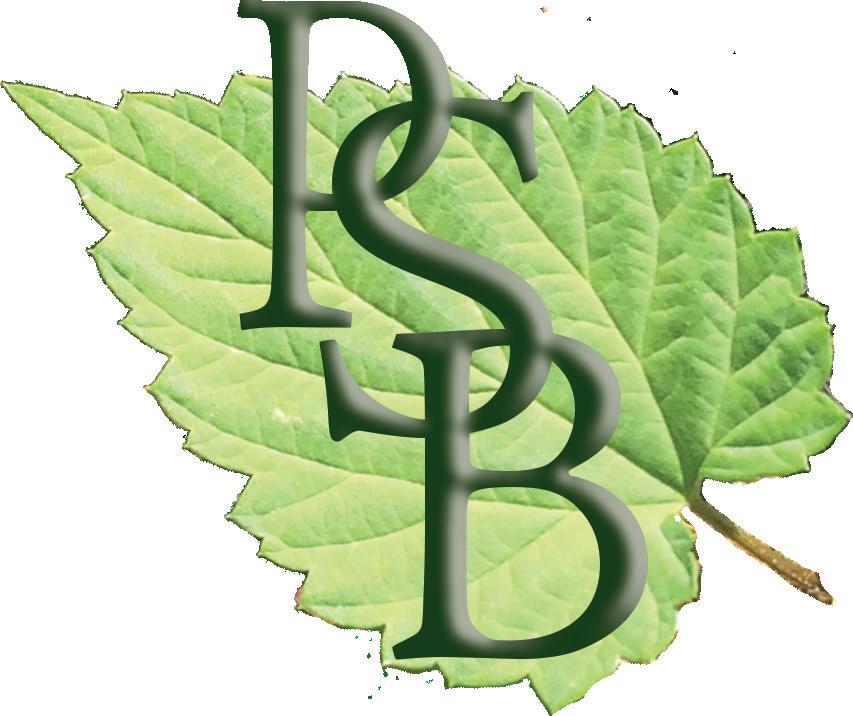
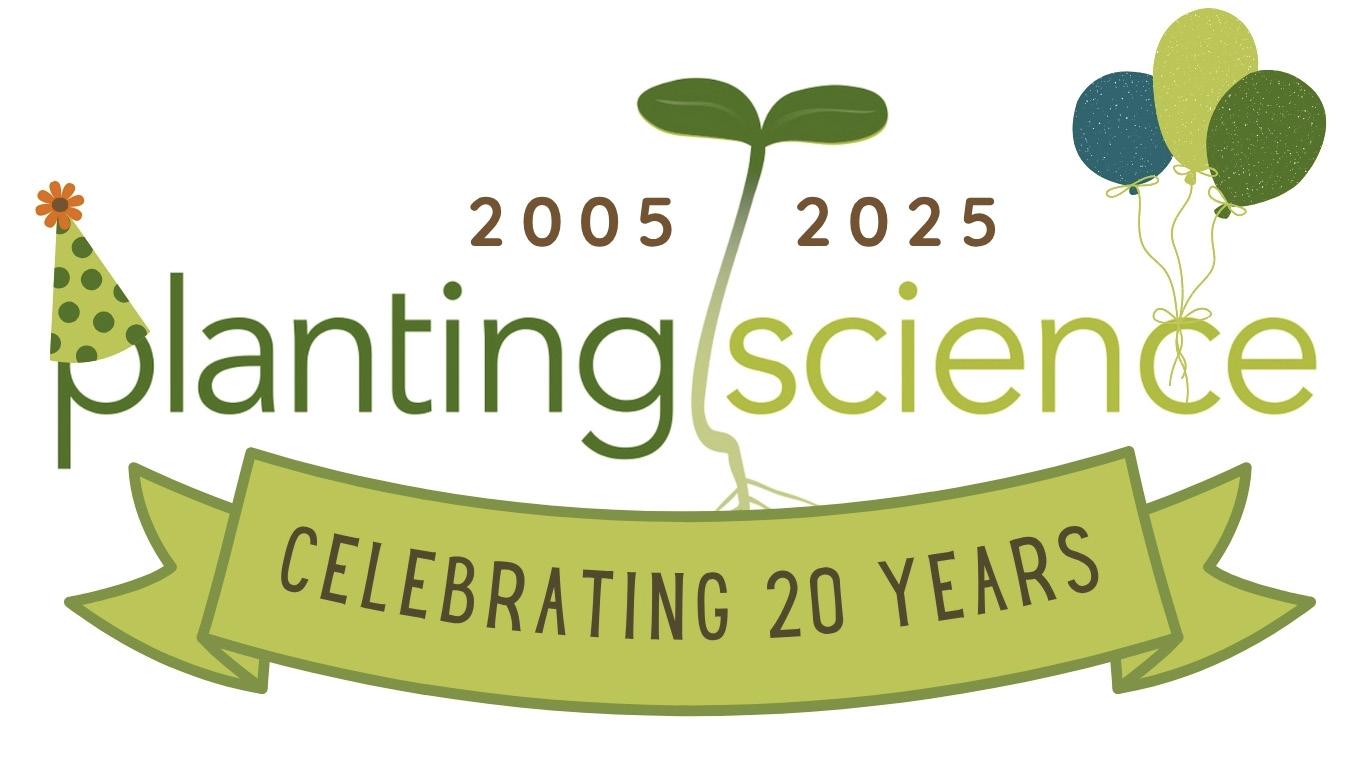

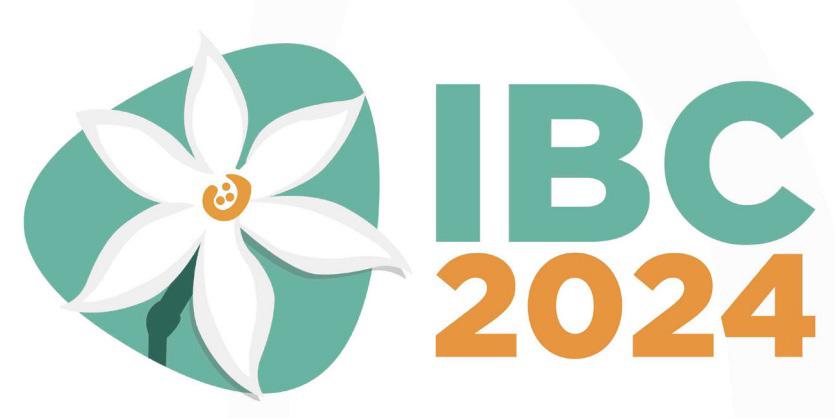
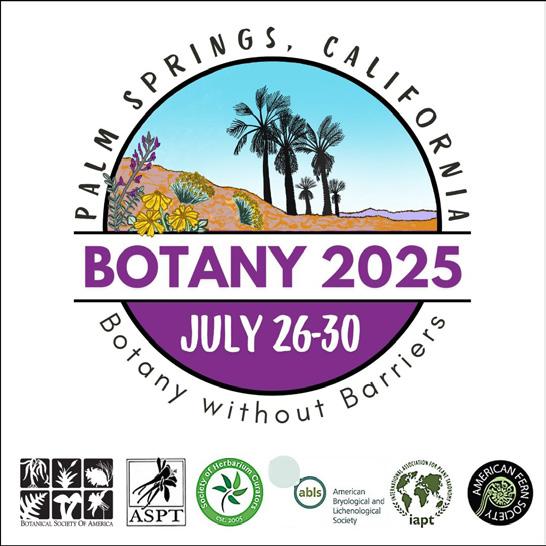








Greetings, botanists!

Summer is fast underway, and we are gearing up for Botany 2025. In this issue, we include information about the conference, as well as a list of this year’s award winners and our newly elected leaders. I want to highlight the article prepared by BSA’s International Affairs Committee about the experiences of the participants of the International Botanical Congress that took place last year in Spain.
I want to acknowledge that it has not been an easy time for scientists, researchers, and students overall. The past six months have brought a wave of uncertainty, with many notices of grant cancellations and terminations leaving many unsure about the future of the scientific enterprise in the US. BSA has lost the funding for the long-standing PLANTS program, which has provided mentorship and training opportunities to more than 150 undergraduate students. According to the New York Times, there has been an overall reduction of 51% in grants awarded by NSF in 2025, with the BIO directorate having a 52% reduction. Additionally, NSF is likely going through a restructuring that would change how funding is disbursed throughout. Harsh immigration policies and political retribution are impacting the country’s ability to welcome international students and scholars, with a yet-to-be-seen effect on the growth and formation of the next generation of scientists. I want to reaffirm that the PSB is a voice for our community. If you have been impacted by cuts, immigration policies or other effects of the current political situation, please write a commentary or article to us to let your voice be heard. Likewise, if you have found a seed of joy in these dark times, we would be happy to hear from you too.
To end with a positive note, we will soon meet again at Botany 2025. More than 1000 botanists from different parts of the world will come together to celebrate our shared scientific curiosity. Let’s take this opportunity to be open, learn from each other, and strengthen our ties and community.
I hope to see you soon!

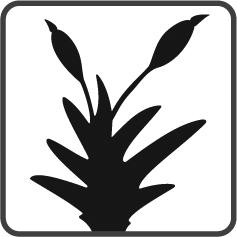
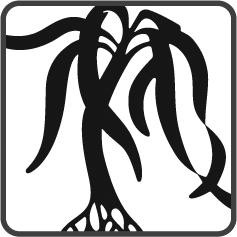
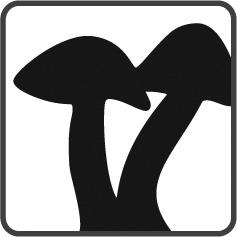

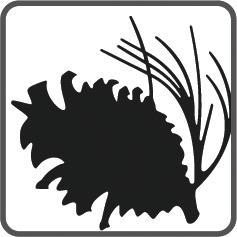


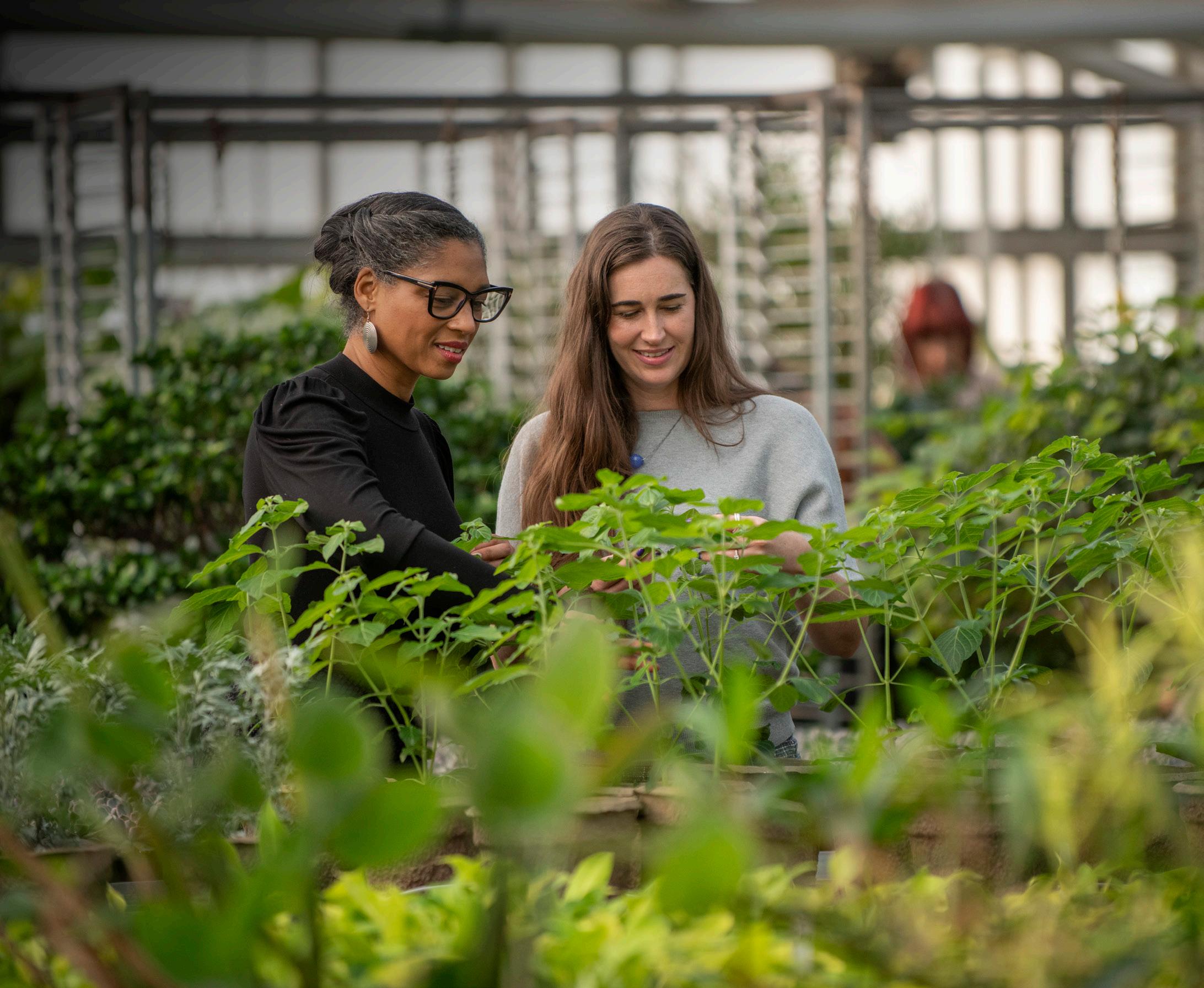
Do you aspire to lead in public gardens?
Are you passionate about using your career to make a positive global impact?
The Fellows Program develops tomorrow’s leaders, preparing them to successfully navigate pressing challenges, develop thoughtful strategies, and lead organizations that are equitable and sustainable.
During the fully funded, leadership accelerator, Fellows engage in project-based learning that allows them to hone their professional skills while delving into issues relevant to the public gardens industry today.
Applications for the 2026–2027 Fellows cohort close July 31, 2025.
Apply now at longwoodgardens.org/fellows-program.


On May 9, the Botanical Society of America received notice from the National Science Foundation (NSF) that they were immediately terminating the grant funding that supports our Botany and Beyond: PLANTS III Program ( https://botany.org/home/awards/travelawards-for-students/plants-grants/plants. html). The PLANTS (Preparing Leaders and Nurturing Tomorrow’s Scientists) program supports 20 undergraduate students with a mentored conference experience each year.
For 15 years, this program has supported 195 students from across the nation with a significant percentage going on to graduate school and botanical careers in industry, agencies, nonprofits as well as teaching in community colleges and high schools. This is a very sad and unprecedented action taken by the NSF driven by the current administration’s priorities. Thousands of scientific grants have been canceled in the last few months and the BSA Board was aware and discussed that these terminations could potentially affect us.
The good news is that BSA leadership greatly values the PLANTS program, which has a strong legacy of success after 15 years of implementation. Despite the lack of outside funding, the BSA will use some of its financial reserves to ensure the 2025 cohort of scholars and mentors can continue with plans for a mentored Botany conference experience in Palm Springs this year. We made a commitment to this cohort and we intend to honor it.
The program remains intact for Botany 2025, and we are communicating this news with our undergraduate scholar cohort, the mentors for the program and our partners at American Society of Plant Taxonomists (ASPT) and Society of Herbarium Curators (SHC). We know what a meaningful experience the PLANTS program brings to our community, and we thank all who have served as mentors, principal investigators, and supporters over the years.
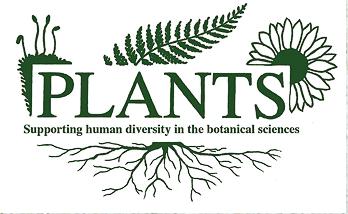
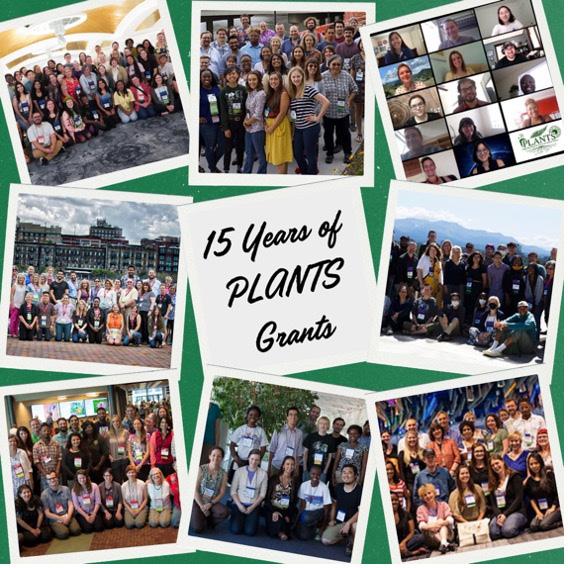
We originally shared this unprecedented change in funding to you in mid-May and have already received over $17,300 in donations from our community, as well as several pledges for more. Thank you if you have already given to this program! Annually the program will cost over $75,000 to run in the same capacity as it has been done before, where scholars are fully funded to attend the conference and peer mentors receive partial scholarships for their time and dedication. If you would like to help support the PLANTS program for 2025 and help us plan for its continued success for next year and beyond, we encourage you to make a donation to the BSA PLANTS Grant Fund (https://crm.botany. org/makeadonation). While we are seeking
private foundation grants, we are turning to our community to fill the gap. Donations of any size will be greatly appreciated! A handful of BSA members make annual gifts to BSA from their qualified retirement accounts to help defer their tax liability. Those annual gifts are much appreciated and have mutual benefits. If you are interested in making a planned gift, endowment, or donation of stock, please contact Heather Cacanindin directly at hcacanindin@botany.org. If you know of a company or organization that might be interested in discussing sponsorship of the PLANTS program, we would also love to hear from you about those ideas. Thanks to our community for all the wonderful support over the years!

Dr. Sean Graham began serving as the new editor-in-chief of the AJB in January 2025. He is a Professor in the Department of Botany at the University of British Columbia, Vancouver, Canada, who has wide-ranging research interests in plant systematics and evolution, and in particular characterizing plant biodiversity from phylogenetic and phylogenomic perspectives. His interests have ranged from addressing challenging higherorder relationships—both across and within the major lineages of land plants—to more focused systematic studies of closely related taxa. Sean has studied the molecular evolution of plant genes and genomes, and the evolution of plant sexual systems. He has strong ongoing research interests in monocots and mycoheterotrophic plants. We wanted to give Sean a chance to describe his thoughts on his new role!
What inspired you to pursue the Editor-inChief position for AJB?
I’ve been a fan of the journal since I was a postdoc in Dick Olmstead’s lab at the University of Washington. (He was the one who really introduced me to the journal.) AJB is highly respected by the botanical community worldwide. It is also a Society-run journal, a huge plus for me. In addition, I am quite nosy and like to see what goes on behind the scenes to better understand how things work. I am generally interested in the processes of writing and editing, from small to large scales. So, chalk some of this up to curiosity and an opportunity for personal growth!
I have deep respect for what previous Editorsin-Chief did for the journal—Pam Diggle being the most recent example—and I aspire to help continue this long tradition. I’ve been an associate editor (AE) at the journal for years, and so I know well that the journal has a lovely and incredibly hard-working staff. It has been such a delight to work with them, which made it so much easier to think about taking on the role as an Editor-in-Chief!
Finally, we live in interesting times: The field of scholarly publishing is changing very rapidly. I want to help the journal and the Society navigate potentially choppy waters, and to contribute to the continuing success of the journal.
What excites you at the moment about working on AJB?
Learning a complex and sometimes difficult new role, and helping the journal to prosper!
What do you see as the main strengths of AJB, and where are areas that could be strengthened?
A major strength is that, as a Society-run journal, our main focus (along with our sister BSA journal, Applications in Plant Sciences [APPS]) is simply on publishing good work. Profit is not the primary motivation, although of course we need to be fiscally responsible.
Funds generated from the journal are returned to the Society to support our community. Thus, a strength is that the journal serves the Society’s members, our authors, and our readers—and not primarily the publisher shareholders.
And although Impact Factor is a serious consideration for all journals, our overarching goal is to be a broadly focused and welcoming journal, for diverse kinds of excellent botanical science from around the world.
We also continue to explore ways to work with our sister journals: APPS and the Plant Science Bulletin (PSB). We’ve been grappling with increasing the number of review articles at AJB, and how best to do that, because these are an impactful form of scientific communication. Along the same lines, the “On the Nature of Things” (OTNOT) articles introduced by my predecessor, Pam Diggle, have been a great addition. I think we should experiment more with new types of articles, and I have some ideas I’d like to explore!
Funds generated from the journal are returned to the Society to support our community. Thus, a strength is that the journal serves the Society’s members, our authors, and our readers—and not primarily the publisher shareholders.
As far as scholarly publishing overall: What do you see as the current challenges and advantages for Society publishers that our community should be aware of?
There are many big challenges. A major one is the rapidly dwindling money we get from library subscriptions and licenses. We are still figuring out how to prosper financially as a Society-run journal in partnership with a major publishing company. So, we are navigating an increasingly Open Access environment that is upending the traditional scholarly publishing model (which may not all be negative!).
For many years, there has been a worldwide push for Open Access, which allows anyone to have access to content—which is good, of course. However, publishing is not inexpensive and this poses exceptional challenges for Society-run journals, especially in fields like ours that often have relatively little money to do research, much less funds to support article publication charges (APCs). Publishers negotiate publishing deals with consortia and institutions (see https://authorservices.wiley. com/author-resources/Journal-Authors/ open-access/affiliation-policies-payments/ institutional-funder-payments.html), but
even these are not available to all of our authors.
However, my biggest concern is a societal one—the effect of generative AI on writing, reading, teaching, learning, and thinking. I am deeply concerned that genAI will have a net negative effect on all of these, and ultimately on scientific discovery. Of course, machine learning and similar approaches have enormous potential for speeding up and expanding botanical research and data exploration. But humans should be at the “centre” [sic; I am Canadian] of how journals work, and who they are ultimately for!
What suggestions do you have for people who might be thinking about submitting an article to AJB?
Please consider submitting your best work to AJB! We have a fantastic team of staff, associate editors. and reviewers who will help you to produce the best paper possible. Your work will get noticed.
How can BSA members support AJB as a strong and influential journal in our field?
See my previous responses! Also: I would ask that the BSA membership please avoid the alarming subset of for-profit journals out there that have predatory practices, leading to significant shortcuts with reviewing and editing. We need to maintain integrity of the publishing process, and keep it fair and equitable for all.
Keep on doing what AJB does well, while experimenting and innovating with new approaches and content to ensure its longterm success. I also want to encourage earlycareer researchers to serve as reviewers and associate editors, and to keep sending your articles to AJB. You, too, could be the AJB Editor-in-Chief in the future!
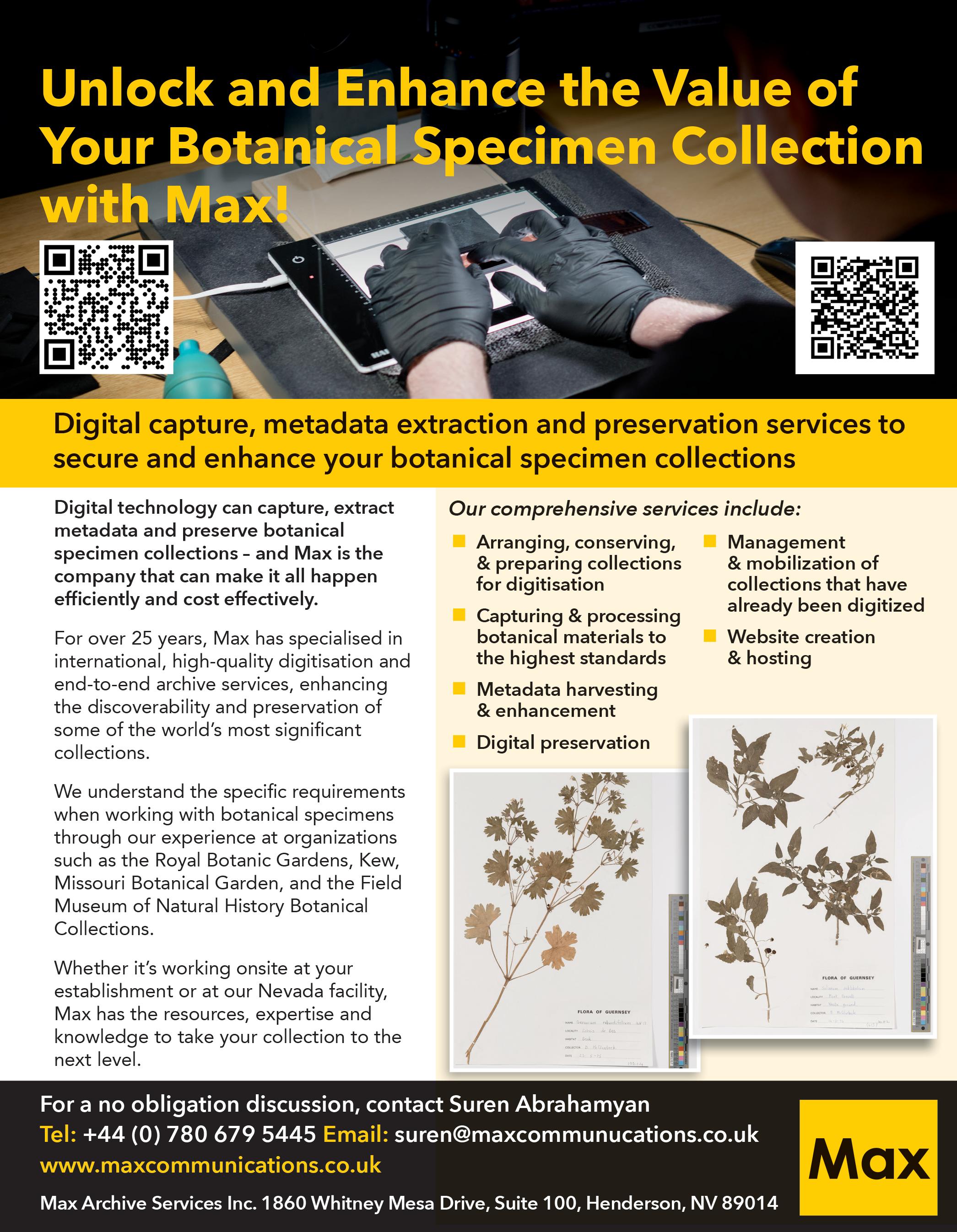
The “Distinguished Fellow of the Botanical Society of America” is the highest honor our Society bestows. Each year, the award committee solicits nominations, evaluates candidates, and selects those to receive an award. Awardees are chosen based on their outstanding contributions to the mission of our scientific Society. The committee identifies recipients who have demonstrated excellence in basic research, education, public policy, or who have provided exceptional service to the professional botanical community, or who may have made contributions to a combination of these categories.
Dr. Tia-Lynn Ashman, University of Pittsburgh
Dr. Mudassir Asrar, University of Balochistan
Dr. Suzanne Koptur, Florida International University

Dr. Tia-Lynn Ashman, Professor at the University of Pittsburgh, has been named a 2025 Distinguished Fellow of the Botanical Society of America in recognition of her transformative contributions to plant science, mentoring, and global scientific collaboration. With over 220 publications and more than 21,000 citations, Dr. Ashman has advanced our understanding of the evolutionary ecology of plant reproduction—particularly through her work on sex chromosome evolution in strawberries, pollen limitation, and polyploidy. Her colleagues describe her as “a visionary, pushing the boundaries of scientific inquiry while maintaining exceptional rigor,” and praise her as “a leader in the field of plant evolutionary ecology.” Her work has not only opened new avenues in botanical research but also reinvigorated interest in long-standing ecological and genetic questions.
Equally impactful is Dr. Ashman’s dedication to mentoring and community-building. Her former students and postdoctoral researchers now thrive in academia, government, and science communication roles, often citing her high standards and unwavering support as pivotal to their success. “She’s tough, she’ll push you, but you’ll accomplish so much. You will become a great scientist,” one mentee recalled. Dr. Ashman has also led major international collaborations and working groups on pollen limitation, emergent sex chromosomes, pollination in biodiversity hotspots and many other topics that synthesize critical knowledge across diverse disciplines, creating tools and frameworks that will guide plant biologists for decades. In the words of another nominator, “She not only advances our field but also cultivates the next generation of scientists, ensuring that her impact extends far beyond her own work.”
As a Meritorious Professor at the University of Balochistan and a global representative of Pakistan in the botanical sciences, Dr. Mudasir Asrar has made lasting contributions in plant biotechnology, medicinal plant research, and science policy. A widely respected scholar and mentor, she has published over 160 research papers, authored 15 books, and presented work in more than 200 national and international conferences. Her impactful leadership includes chairing the Pakistan Council for Science and Technology and contributing to national STI policy development. One nominator praised her “unparalleled commitment to advancing plant sciences in Pakistan and globally,” citing her as a “trailblazer for women in science.”

Dr. Asrar’s influence extends well beyond academia. She has led the establishment of pioneering scientific infrastructure in Pakistan, including botanical gardens and tissue culture laboratories. As a dedicated mentor, she has supervised hundreds of students across all levels of higher education. Her work in digitizing the flora of Balochistan in collaboration with international partners has opened new frontiers for biodiversity research. As another nominator reflected, “Dr. Asrar’s legacy is defined not only by scientific achievement but also by her unyielding efforts to uplift communities through education and innovation.”

Dr. Suzanne Koptur has been named a 2025 Distinguished Fellow of the Botanical Society of America in recognition of her four-decade-long career marked by excellence in botanical research, education, and conservation. A Professor Emerita at Florida International University, Dr. Koptur is internationally recognized for her pioneering work on plant-insect interactions, particularly the role of extrafloral nectaries in ant-plant mutualisms. Her influential publication on these interactions has become a foundational resource in the field, with over 500 citations.
Beyond academia, Suzanne’s leadership in conservation initiatives, such as co-founding the Native Plant Network has had lasting impact on the preservation of Florida’s endangered Pine Rockland ecosystem. “Her love for
plants and for their protection has been a gift to the public and scientific community alike,” wrote one nominator. Known for her inspiring mentorship—particularly of women and those underrepresented in science—Dr. Koptur has guided over 30 graduate students, cultivated public engagement through education and outreach, and remains a great favorite among students, staff, and faculty. One nominator stated, “Suzanne has excelled at everything she does, be it academics, research in lab or field, presentation, teaching, professional or public service. Her background is diverse and impressive. Be we student or colleague, Suzanne knows how to cultivate the best in us. She is an engaging persona, upbeat, with exacting standards for herself and others, yet she is compassionate, patient, genuinely kind, and fun. She has trained hundreds of students during her tenure at FIU and elsewhere.” In addition, Dr. Koptur has contributed active leadership to the Florida Native Plant Society, Native Plant Day, the Endangered Plant Advisory Committee of the State of Florida, the Rare Plant Task Force, and through her membership in many other local conservation organizations. We cannot imagine a more deserving awardee than Suzanne.
The Botanical Society of America Impact Award recognizes a BSA member or group of members who have significantly contributed to advancing diversity, accessibility, equity, and/or inclusion in botanical scholarship, research and education.

University of Georgia
(BSA in association with the Teaching Section and Education Committee)

Cartoonist – PlantsGoGlobal.com
Naomi Volain is an innovative nationally recognized high-school science teacher and science communicator. Since 2008, she has engaged her students in PlantingScience activities, earning multiple Star Project Awards. She also advised revisions of the program, impacting hundreds of teachers and thousands of students nationwide. Ms. Volain served on the advisory board for the NSF-funded grant “Digging Deeper Together,” focused on teacher–scientist professional development. She created and taught the first Botany course at her school, revitalizing the greenhouse (still named in her honor). She is a valued mentor to new teachers, and one nominator described her as “the most dedicated teacher, especially in botany.” Ms. Volain has also developed online botanical resources, including the “Plants Go Global” website. As one nominator stated, “She truly is a rockstar educator and science communicator.”
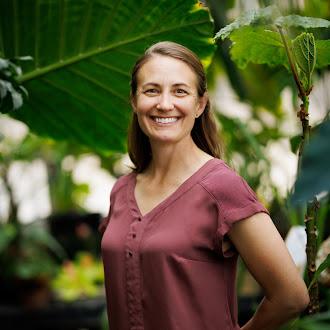
Cal Poly State University, San Luis Obispo
Dr. Jenn Yost, Associate Professor and Director of the Herbarium at California Polytechnic State University, is a dedicated educator and impactful California botanist. She has expanded the herbarium by training students and community members in collection techniques, leading digitization efforts across California, and incorporating cutting-edge digital analyses. Many student research projects and classes utilize the extensive collection. Dr. Yost also engages with local communities through the Urban Forest Ecosystem Institute, gives many public lectures, and leads local tree-planting initiatives. Her well-organized field botany courses have trained hundreds of students, earning praise from nominators for her energy and ability to simplify complex concepts. As nominators note, she “saturates every sentence with enthusiasm” and “being a student with Jenn is like being a kid again—every moment is filled with discovery and delight.”
This award was created to promote research in plant comparative morphology, the Kaplan family has established an endowed fund, administered through the Botanical Society of America, to support the Ph.D. research of graduate students in this area.
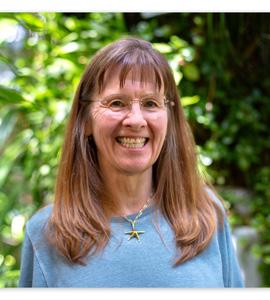
Dr. Pamela Diggle University of Connecticut
This award was established in 2006 by Dr. Barbara D. Webster, Grady’s wife, and Dr. Susan V. Webster, his daughter, to honor the life and work of Dr. Grady L. Webster. After Barbara’s passing in 2018, the award was renamed to recognize her contributions to this field of study. The American Society of Plant Taxonomists and the Botanical Society of America are pleased to join together in honoring both Grady and Barbara Webster. In odd years, the BSA gives out this award and in even years, the award is provided by the ASPT.
Jacob S. Suissa, Andrews A. Agbleke, William E. Friedman
A bump in the node: The hydraulic implications of rhizomatous growth
American Journal of Botany, January 2023 110(1): e16105
(These include the BSA Professional Members Travel Awards, the Developing Nations Travel Awards, and the Hardship Travel Awards)
Ellie Becklund, University of Connecticut and Ohio University
Timothy James Biewer-Heisler, Indiana University
Betsy Justus Briju, G.S.Gawande College
Marco Chiminazzo, São Paulo State University (UNESP)
Israel L. Cunha-Neto, New York University
Hilary Rose Dawson, Australian National University
Jenna Ekwealor, San Francisco State University
Jessamine Finch, Atlanta Botanical Garden
Vikas Garhwal, Indian Institute of Science Education and Research Kolkata
Ash Hamilton, University of Chicago / The Morton Arboretum
Wen-Hsi Kuo, Missouri Botanical Garden
Isabela Lima Borges, Santa Barbara Botanic Garden
Oranys Marin, University of Utah
Mason McNair, Michigan State University
Damilola Odumade, University of Kansas
Rebecca H. Penny, Aquinas College
Diana Karen Pérez Lara, EAFIT University
Malka Sava, Quaid-i-Azam University
Nathália Susin Streher, University of Pittsburgh
Mariana Vazquez, Connecticut College
Yannick Woudstra, Stockholm University
Eric Yee, University of Pittsburgh
Wenbin Zhou, UNC Chapel Hill
The Samuel Noel Postlethwait Award is given for outstanding service to the BSA Teaching Section.
Kyra Krakos, Maryville University
This award organized by the Environmental and Public Policy Committees of BSA and ASPT aims to support local efforts that contribute to shaping public policy on issues relevant to plant sciences.
Kimberly Brown
For the proposal: Creating Accessible and Educational Native Plant Gardens
The Public Policy Award was established in 2012 to support the development of of tomorrow’s leaders and get a better understanding of this critical area.
Rina Talaba, Chicago Botanic Gardens and Northwestern University
Katherine Wolcott, University of Miami
This award is named in honor of the late Dr. AJ Harris whose research spanned traditional specimen-based science, paleobotany, phylogenomics, biogeography, and computational biology. This award is given in conjunction with the Graduate Student Research Awards and is given to a graduate student whose research is representative of one of the areas above.
Nora Heaphy, University of Vermont
For the Proposal: Adaptive introgression and demographic structure in a keystone northern forest tree
This award was created to promote research in plant comparative morphology, the Kaplan family has established an endowed fund, administered through the Botanical Society of America, to support the Ph.D. research of graduate students in this area.
Oluwatobi Oso, Yale University
For the Proposal: Comparative Morphology of Leaf Development: Bud Packing and Cellular Mechanisms Driving Evolution Across Latitudinal Gradients.
Honorable Mention:
Christopher Joaquín Muñoz, The University of Texas at El Paso
For the Proposal: Trait Evolution in Hebecarpa (Polygalaceae).
This award supports the Ph.D. research of graduate students in the area of comparative plant biology, broadly speaking, from genome to whole organism. To learn more about this award click here.
Sara Sofia Pedraza Narvaez, University of California–Los Angeles
For the Proposal: Comparative phylogeography and thermal performance of four clades of montane tree species: an integrative approach to study diversification of tropical plants
The BSA Graduate Student Research Awards support graduate student research and are made on the basis of research proposals and letters of recommendations. Within the award group is the Karling Graduate Student Research Award. This award was instituted by the Society in 1997 with funds derived through a generous gift from the estate of the eminent mycologist, John Sidney Karling (1897-1994), and supports and promotes graduate student research in the botanical sciences.
Anthony Garcia, University of Washington
For the Proposal: Developmental genetics of carpel innovations mediating pollination
Katherin Arango-Gómez, Louisiana State University
For the Proposal: Exploring Montane Forests to Unveil Patterns of Range Sizes in the Neotropical genus Cavendishia (Ericaceae)—A phylogenetic approach
Shawn Arreguin, University of Illinois at Chicago
For the Proposal: Urbanization and its impact on reproductive strategies: A case study of cleistogamy in Lamium amplexicaule
Louisa Bartkovich, University of Toronto
For the Proposal: Decoupling the effects of warming and canopy cover on reproductive phenology in the spring ephemeral Erythronium americanum
Rachel L. Benway, Syracuse University
For the Proposal: Fungal Community Shifts Across the Temperate-Boreal Ecotone
Lena Berry, University of Wisconsin-Madison
For the Proposal: Physiological Function of Transfusion Tracheids in the Cupressaceae
Charles Boissavy, Claremont Graduate University (California Botanic Garden)
For the Proposal: Phylogenetics, Taxonomy, Trait Evolution, and Biogeography of the Latifolia Clade in Eriogonum
Rachel O. Cohen, Columbia University
For the Proposal: An investigation of haustoria-associated genes in the facultative hemi-parasite Pedicularis groenlandica
María Cuervo-Gómez, University of Florida
For the Proposal: Influence of autopolyploidization on the phenotype and vulnerability to drought and heat in Arabidopsis thaliana
Cael Dant, Northwestern University
For the Proposal: Understanding the impact of prey type and the pitcher microbiome on physiological success of the carnivorous plant Sarracenia purpurea
Mahima Dixit, Claremont Graduate University
For the Proposal: Phylogeny, Phytochemistry, and Taxonomy of Eriogonum subg. Ganysma with a Focus on the E. deflexum Complex (Polygonaceae)
Sanika Goray, Indian Institute of Science Education and Research (IISER) Bhopal
For the Proposal: A multifaceted approach to explore the taxonomic identity of an endemic, polymorphic Balsam from the Western Ghats, India
Anupreksha Jain, University of Wisconsin – Madison
For the Proposal: Plant-pollinator interactions after drought: integrating plant physiology, floral rewards, and pollinator behavior
Jeffrey Keeling, University of Texas at El Paso
For the Proposal: Eriophorum vaginatum phytobiome in central, northern Alaska
Kyla Knauf, Northwestern University and the Chicago Botanic Garden
For the Proposal: From Flowers to Seeds: Understanding the Effects of Climate Change on Rocky Mountain Wildflower Phenology and Reproduction
Kiona A. Leeman, University of Wisconsin - La Crosse
For the Proposal: Aphyllon assembly: elucidating the phylogenetics of a genus of non-photosynthetic angiosperms using the Angiosperms353 probe kit
Benjamin Lloyd, University of Washington
For the Proposal: A Deep Learning Approach to the Phylogenetic Placement of Fossil Grass Silica Short Cell Phytoliths
Victoria Martinez Mercado, Northwestern University
For the Proposal: Multi-omic Approach for Pollen Banking in Asimina triloba: A Model for Conservation
Charli Minsavage-Davis, Georgetown University
For the Proposal: Testing for adaptation in the clonal salt marsh grass Spartina patens with a novel coalescent model and DNA-sequence polymorphisms
Whitney A. Murchison-Kastner, Tulane University
For the Proposal: Investigating parallel evolution in two Mimulus species using comparative quantitative trait loci mapping
Nicole Phelan, University of Vermont
For the Proposal: Resolving Hybrid Origins in a Wild Sunflower (Helianthus) Species Complex
Riya Rampalli, Columbia University
For the Proposal: Consequences of sexual dimorphism on the evolution of amaranths: insights from hybrid recombination maps and genetic incompatibilities
Yanã Rizzieri, Cornell University
For the Proposal: Investigating genome evolution in the water ferns (Salviniales) and its relationship to heterospory
Rhuthuparna S B., Indian Institute of Science Education and Research, Bhopal, India
For the Proposal: Outcrossing to selfing: Understanding the functional and evolutionary implications of herkogamy in an enantiostylous genus
Yogesh Sharma, Kurukshetra University, Kurukshetra, Haryana, India
For the Proposal: Floristic Studies of The Diversity of Grasses (Agrostology) in Haryana, India: A Comprehensive Survey and Digital Documentation
Sarah Ellen Strickland, University of Florida
For the Proposal: How do they handle the heat? A Comparison of allopolyploid Tragopogon miscellus and its diploid parents under heat and drought stress
Daniel Wehner, SUNY College of Environmental Science and Forestry
For the Proposal: An Uphill Battle: Seed dispersal and mycorrhizal constraints on the climate-driven upslope migration of trees species in the northeastern U.S.
The BSA Undergraduate Student Research Awards support undergraduate student research and are made on the basis of research proposals and letters of recommendation.
Andrew Conlon, Emory University
For the Proposal: Determining Selective Cytotoxic and Antibiotic Properties of Teucrium flavum L. for Public Safety and Medical Advancement. Co-authors: Dr. Cassandra Quave, Dr. Tharanga Samarakoon, Nadia Aziz, Marco Caputo
Lena Kadau, University of South Carolina
For the Proposal: Seed Mucilage Trait Evolution Across Populations and Species of Linum.
Will Pearce, University of Utah
For the Proposal: Intraspecific Variation and Species Boundaries of the Desert Gooseberries (Ribes series Microphylla). Co-author: Dr. Rodolfo Probst
Alex Risdal, Loyola University Chicago
For the Proposal: Habitat Evaluation and Species Distribution Modeling for Michigan’s Bladderworts (Utricularia spp.). Co-authors: Dr. Brian Ohsowski, Dr. Mike Grillo, Shane Lishawa
Nicole Stark, The University of Alabama in Huntsville
For the Proposal: Uncovering the Origin and Genomic Mechanism of Dioecy in the Family Fabaceae.
Brooke C. Tillotson, SUNY Cortland
For the Proposal: Investigating the correlation between homeolog bias and differences in phenotype and pigment composition in Nicotiana quadrivalvis and N. clevelandii allopolyploids.
The PLANTS (Preparing Leaders and Nurturing Tomorrow’s Scientists: Increasing the diversity of plant scientists) program recognizes outstanding undergraduates from diverse backgrounds and provides travel grant.
Ormary Alvarez, Lehman College, Advisor: Cecilia Zumajo
Mickie Barraza, New Mexico State University, Advisor: Sara Fuentes -Soriano
Abbigale Baum, Utah Valley University, Advisor: Michael C. Rotter
Kathryn Bourlier, Old Dominion University, Advisor: Erik Yando
Leo Case, Oregon State University, Advisor: Gail Langellotto
Gianna Claude, Old Dominion University, Advisor: Nicholas Flanders
James Davis, Oklahoma State University, Advisor: Cody Howard
Muriel Draper, Old Dominion University, Advisor: Erik Yando
Marissa Falla, California State Polytechnic University, Pomona, Advisor: Mare Nazaire
Nova Hodgson, Oregon State University, Advisor: Gar Rothwell
Abigail Kohn, University of Michigan, Advisor: Selena Smith
Jada Martinez, University of North Texas, Advisor: Elinor Lichtenberg
Marissa Mc Lean, SUNY Cortland, Advisor: Elizabeth McCarthy
Victor Melendez Maldonado, Christopher Newport University, Advisor: Janet Steven
Maylin On, Cal Poly Humboldt, Advisor: Alana Chin
Tyler Radtke, University of Florida, College of Liberal Arts and Sciences, Advisor: Pam Soltis, Doug Soltis
Andrew Ruegsegger, University of Arkansas, Fayetteville, Advisor: Maribeth Latvis
Charlotte Saltsman, Murray State University, Advisor: Ingrid Jordon-Thaden
Icyss Sargeant, Louisiana State University, Advisor: Laura Lagomarsino
Alysha Schjelderup, University of California Santa Cruz, Advisor: Jarmilla Pitterman
Dailyn Wold, University of Wisconsin Eau Claire, Advisor: Nora Mitchell
The purpose of these awards is to offer individual recognition to outstanding graduating seniors in the plant sciences and to encourage their participation in the Botanical Society of America.
Sabilah Alibhai, Connecticut College, Advisor: Rachel Spicer
Sofía Elizabeth Báez, Old Dominion University, Advisor: Lisa Wallace
Edie L. Banovic, Connecticut College, Advisor: Rachel Spicer
Tori Barrow, Colorado College, Advisor: Rachel Jabaily
Rebecca Beneroff, Bucknell University, Advisor: Chris Martine
Ana Bermudez, Connecticut College, Advisor: Rachel Spicer
Kendall Cross, St. Cloud State University, Advisor: Angela McDonnell
Olivia Demetrakopoulos, University of Guelph, Advisor: Edeline Gagnon
Madison N. Dimarco, University of South Carolina, Advisor: Eric LoPresti
Andy Dorsel, Bucknell University, Advisor: Chris Martine
Sebastian Fernandez, University of Florida, Advisor: Makenzie Mabry
Addison Gensch, University of Minnesota - Twin Cities, Advisor: Alexandra Crum
Alise Catherine Griffiths, University of Guelph, Advisor: Christina Caruso
Kaitlin Henry, Bucknell University, Advisor: Chris Martine
Lena P. Kadau, University of South Carolina, Advisor: Eric LoPresti
Aspen Mazzatta, University of Tennessee, Advisor: Jessica Budke
Caelen McCabe, University of Guelph, Advisor: Christina Caruso
Anna Mele, Portland State University, Advisor: Mitch Cruzan
Elisabeth Moore, Barnard College, Advisor: Hilary Callahan
Abigail Motter, Bucknell University, Advisor: Chris Martine
PJ Newhart, Bucknell University, Advisor: Chris Martine
Diandra Polt, Brown University, Advisor: Rebecca Kartzinel
Tyler Radtke, University of Florida, Advisor: Makenzie Mabry
Charlotte Saltsman, Murray State University, Advisor: Ingrid Jordon-Thaden
Yash Kumar Singhal, University of Toronto, Advisor: John Stinchcombe
Isabel Smalley, University of Minnesota Duluth, Advisor: Amanda Grusz
Torrance Wagner, Connecticut College, Advisor: Rachel Spicer
Winners were selected by lottery
Dan J. Coles
Amadeu dos Santos-Neto
Vandana Gurung
Kiona A. Leeman
Whitney Murchison-Kastner
Kasey K. Pham
Mia Stevens
Marisa Blake Szubryt
Yannick Woudstra
Matthew Yamamoto
The following winners were selected from the Association of Southeastern Biologists meeting that took place at the end of March 2025.
Daniel Stanton, UF IFAS Citrus Research and Education Center
Southeastern Section Poster Presentation Award
Annabelle Mayes, Georgia Southern University
Jeremy W. Howland, City University of New York, Advisor: James Lendemer
For the Presentation: Karinomyces (Pilocarpaceae), a new genus for the Appalachian endemic Schadonia saulskelleyana supported by molecular and phenotypic data
Zoe Ryan, University of Wisconsin-Madison, Advisor: Ken Cameron
For the Presentation: Open-source software integration: A tutorial on species distribution mapping and ecological niche modeling
Sarita Munoz-Gomez, Auburn University; Advisor: Daniel S. Jones
For the Presentation: Dioecy and sex determination across the development of the dioecious genus Baccharis (Asteraceae)
Austin Nguyen, University of Kansas; Advisor: Kelly Matsunaga
For the Presentation: Duplication and subfunctionalization of AGAMOUS genes in the cypress family (Cupressaceae)
Arezoo Fani, University of Kansas; Advisor: John Kelly
For the Presentation: Transgenerational Plasticity Enhances Offspring Fitness in Competitive Environments Through Epigenetic Mechanisms
Jill M. Love, Tulane University; Advisor: Kathleen Ferris
For the Presentation: Investigating the adaptive significance of leaf shape plasticity in a California endemic plant, Mimulus laciniatus
Alex Risdal, Loyola University Chicago; Advisor: Brian Ohsowski
For the Presentation: Modeling a Murderer: Determining the Ecological Requirements of Michigan’s Bladderworts
Tabassum Tamima, St. Cloud State University
For the Presentation: Management of Chilli Leaf Curl Virus (ChLCV) of Chilli using selected Agrobotanicals, Raw cow milk, Bioagent and Insecticide under field condition
Seongyeon Kang, University of Arizona, Advisor: Michael S. Barker
For the Presentation: Inferring ancient tetraploidy and hexaploidy using a machine learning approach. Co-authors: Michael McKibben and Michael S. Barker
Max Botz, University of Minnesota Duluth, Advisor: Amanda Grusz
For the Presentation: Does abiotic environment shape patterns of polyploidy and reproductive mode in ferns?
Dusty Prater, University of Tennessee, Knoxville, Advisor: Jacob S. Suissa
For the Presentation: Putting ferns on the map: global patterns of wide-ranging fern species
Mahima Dixit, Claremont Graduate University/California Botanic Garden
Jared B. Meek, Columbia University
(BSA in association with the Developmental and Structural Section)
This award was named in honor of the memory and work of Dr. Vernon I. Cheadle.
Andrea D. Appleton, Harvard University, Advisor: Elena Kramer
For the Presentation: Morphological and developmental novelties within the intricate androecium of Loasaceae
Jaxon Reiter, University of Lethbridge, Advisor: Dr. Elizabeth Schultz
For the Presentations: “Alles ist Blatt ” —The role of auxin in gynoecium development: insights from leaf patterning genes and ovule defects in Arabidopsis thaliana PIN localization pathway mutants lead to reduced seed set
Niall S. Whalen, Florida State University, Advisor: Gregory Erickson
For the Presentation: Phytolith morphological diversity across the gymnosperm phylogeny—implications for phytolith evolution and their paleobotanical applications
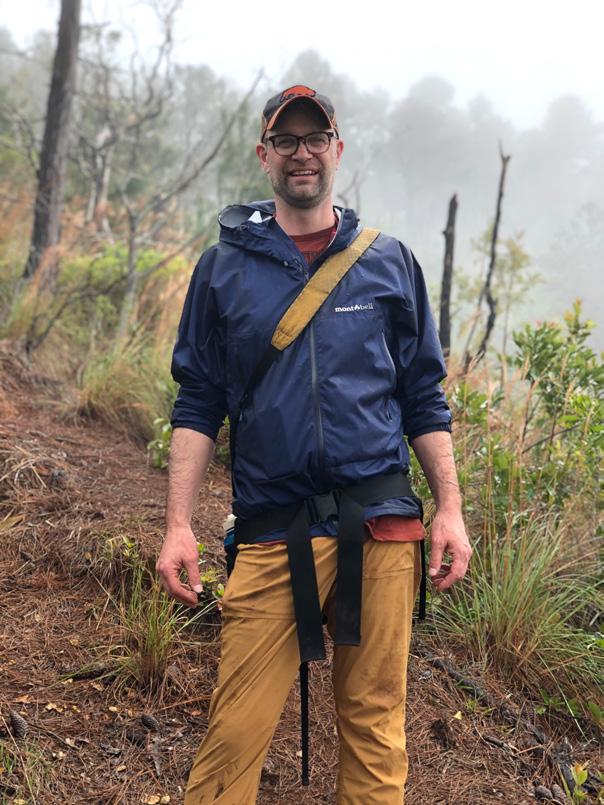
CHRISTOPHER MARTINE BUCKNELL UNIVERSITY
President Elect

ALLISON MILLER
ST. LOUIS UNIVERSITY
DANFORTH PLANT SCIENCE
CENTER
Treasurer

THERESA CULLEY UNIVERSITY OF CINCINNATI
Director at Large for Publications

SARA PEDRAZA NARVAEZ UNIVERSITY OF CALIFORNIA, LOS ANGELES
Student Representative
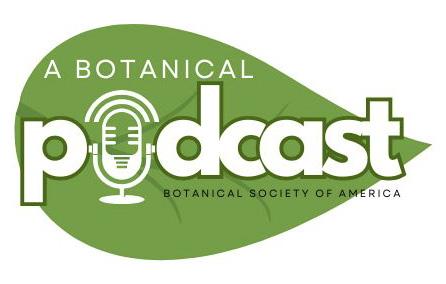
The Botanical Society of America is thrilled to announce a new podcast series with interviews from a variety of botanical science researchers: “A Botanical Podcast!” The podcast will focus on research and topics found in the BSA’s publications—American Journal of Botany, Applications in Plant Sciences, and Plant Science Bulletin—along with other unique topics. BSA member Dr. Shiran Ben Zeev serves as this season's host/producer of the “A Botanical Podcast,” which will feature discussions with botanists explaining their research and their passion for plants (and allied organisms). Download episodes from the main streaming platforms (Apple, Spotify, etc.) or from our hub at https://www.buzzsprout. com/2446995 Here are the four episodes of season 1:

Dr. Shiran Ben Zeev
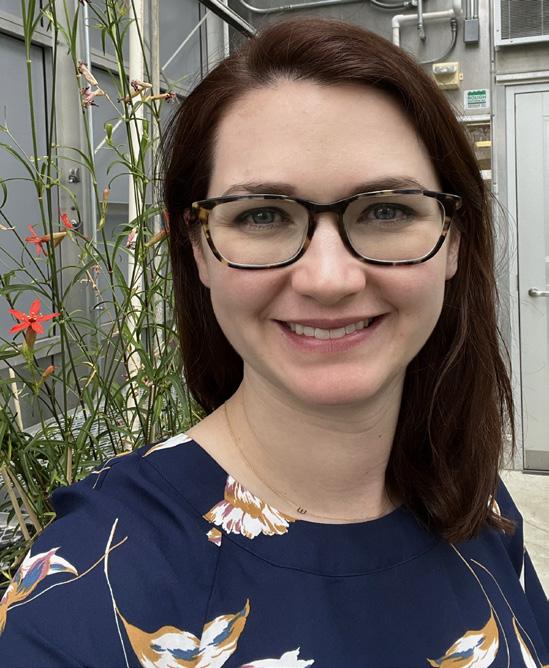
Dr. Andrea E. Berardi: “Paradigm Shifts in Flower Color”
Dr. Berardi from James Madison University discusses the evolution of flower color and why plants change their colors. The role of plantpollinator interactions and environmental relationships is also raised. This topic ties into the upcoming “Paradigm Shifts in Flower Color” special issue of the American Journal of Botany. Berardi is an Assistant Professor at James Madison University in Harrisonburg, Virginia. She is a plant evolutionary biologist whose research focuses on evolutionary, genetic, and ecological processes underlying speciation, specifically focusing on how floral traits play a role in reproductive isolation and adaptation to the environment. Her favorite traits to study are floral color and plant secondary/specialized metabolites.
https://www.buzzsprout.com/2446995/ episodes/16526788

Jordan Dowell:
“Plants Communicating Through Chemistry”
In this episode, Shiran and Jordan Dowell nerd out on a discussion of how plants choose to defend themselves against predators and/ or manipulate other organisms to help them live their best lives, and how plants use chemistry to communicate—and what we can learn from that. They talk about the special challenges of surviving and thriving in harsh environments and touch on the evolution of chemical diversity and the effects of chemical diversity on organismal interactions across spatial and temporal scales. Dr. Dowell is an assistant professor at Louisiana State University and an Associate Editor of the BSA's Applications in Plant Sciences. He studies the evolutionary ecology of plant-plant chemical communication and the impacts of multifunctional traits on biotic interactions from single-cells to landscapes using various techniques, from metabolomic and genomic approaches to remote sensing and field-based studies.
https://www.buzzsprout.com/2446995/episodes/16564616
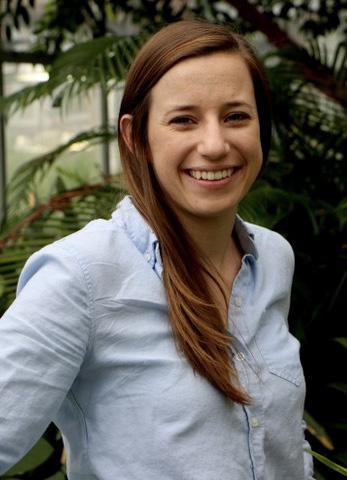
Erica Lawrence-Paul:
“Let's Look at Vegetative Phase Change”
Is it better/more advantageous to be a juvenile or an adult? As with humans, in plants, "it’s complicated"! In this episode, Erica Lawrence-Paul discusses vegetative phase change in plants, i.e., the transition between juvenile and adult phases of vegetative growth. This transition can be visually subtle and easy to overlook in many species; however, morphological and physiological differences between juvenile and adult phases can lead to meaningful differences in plant and tissue function. Dr. Lawrence-Paul is an NSF postdoctoral fellow in Dr. Jesse Lasky’s lab in the Department of Biology at the Pennsylvania State University. She earned her doctorate at the University of Pennsylvania, studying the ecophysiological significance of the plant developmental transition, vegetative phase change, with a particular focus on photosynthetic and leaf carbon economic traits. Her current work focuses on understanding how natural variation in the timing of vegetative phase change and phase-specific differences in stress tolerance contribute to plant abiotic stress response and local adaptation.
https://www.buzzsprout.com/2446995/episodes/16870080

In this episode, Shiran and Dr. Jessica Savage have a wide-ranging conversation about how flowering plants respond to shifting seasonal changes in temperatures, especially when those changes are unpredictable—early warming periods (false springs), followed by light or hard freezes. What is the difference between plants that flower and those that wait? What is the impact of freezing on plants in flower? Dr. Savage draws on research by her and people in her lab who are working to help us better understand the physiological
basis of plant phenology and seasonality. Dr. Savsage is a whole plant physiologist with expertise in vascular physiology, floral physiology, phenology, and physiological ecology in seasonally cold climates. She has a strong disposition toward research tied to the phloem. She is an Associate Professor at a primary undergraduate institution and has a passion for mentoring undergraduate and graduate students (especially master’s students). She developed and runs a community-engaged research program focused on tree phenology in coastal forests around Lake Superior and is the Chair of the Physiological and Ecophysiological Section of BSA. Before starting as a faculty member, she was a Putnam Research Fellow at the Arnold Arboretum and a postdoctoral fellow at Harvard University. She received her PhD from the University of Minnesota in Plant Biological Sciences.
https://www.buzzsprout.com/2446995/episodes/16870555
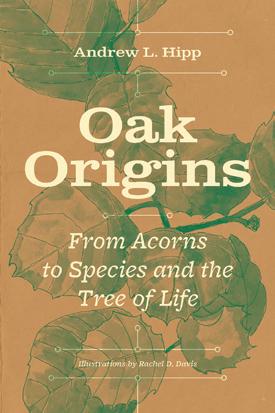
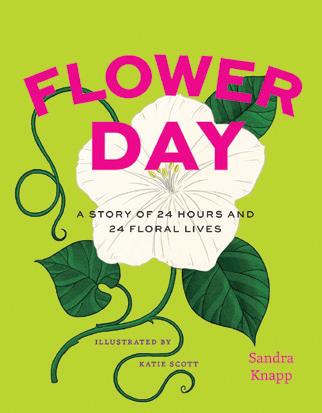
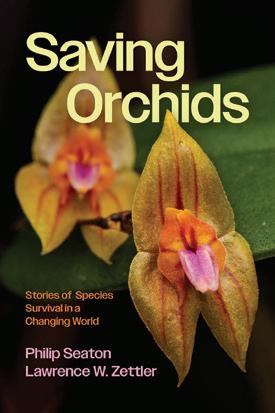
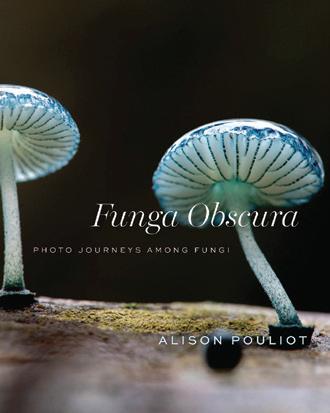
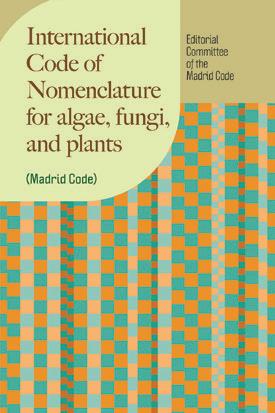
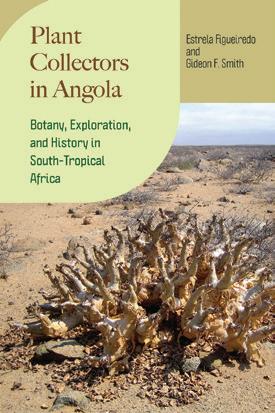
From Acorns to Species and the Tree of Life
Andrew L. Hipp
Illustrated by Rachel D. Davis
With a Foreword by Béatrice Chassé
“Hipp comes closer than any other author that I’m aware of to making sense of this bafflingly complex story.”—Quarterly Journal of Forestry
Cloth $35.00
A Story of 24 Hours and 24 Floral Lives
Sandra Knapp
Illustrated by Katie Scott
“Knapp masterfully intertwines the botany, plant biology, history, evolution, and ecology of twenty‑four species.”—Allison Miller, Donald Danforth Plant Science Center and Saint Louis University
EARTH DAY
Cloth $18.00
Stories of Species Survival in a Changing World
Philip Seaton and Lawrence W. Zettler
“Seaton and Zettler outline the many mistakes made over the last few centuries that landed us in rather dire straits as well as some of the modern solutions that could be employed by diverse stakeholders.”—Tom Mirenda, coauthor of The Book of Orchids
Cloth $35.00
Photo Journeys Among Fungi
Alison Pouliot
“Ecologist and environmental photographer Alison Pouliot has a focus on fungi and her pictures take us across continents and hemispheres.”—Canberra Times
Cloth $28.00
Editorial Committee of the Madrid Code
Contributions by Nicholas J. Turland, et al.
The latest, updated edition of the essential, authoritative reference for botanical, mycological, and phycological names.
REGNUM VEGETABILE
Paper $45.00
Botany, Exploration, and History in South‑Tropical Africa
Estrela Figueiredo and Gideon F. Smith
“This book fills a serious void in the current knowledge of the botanical history of Africa and will serve as the reference for botanical exploration in Angola.”
—Gerry Moore, botanist
REGNUM VEGETABILE
Paper $45.00
The University of Chicago Press www.press.uchicago.edu

This article, prepared by the International Affairs Committee of the Botanical Society of America, shares personal impressions and valuable insights from attendees of the XX International Botanical Congress (IBC) in Madrid, Spain, which took place in July 2024. The IBC is a pivotal event in the botanical community, drawing researchers, educators, and enthusiasts from around the globe. Held every six years, the IBC provides an environment for discussing the latest advances in plant science and updating the International Code of Nomenclature for algae, fungi, and plants—the rules governing the naming of these organisms (Turland, 2025). The XX
By
Shengchen Shan1, Veronica Di Stilio2, Shelley A. James3, Julie F. Barcelona4, Oluwatobi A. Oso5, Funmilola M. Ojo6, Allyssa Richards7, and Elton John de Lirio8
1 Florida Museum of Natural History, University of Florida, Gainesville, FL, United States.
2 Department of Biology, University of Washington, Seattle, WA, United States.
3 Western Australian Herbarium, Department of Biodiversity, Conservation and Attractions, Kensington, Australia.

IBC was a large scientific meeting, with 3011 attendees from 95 different countries, 267 symposia, and more than 3000 talks and posters (Gostel et al., 2024)—a daunting event for even a seasoned scientific professional. By summarizing experiences of the meeting from undergraduate and graduate students to senior scientists attending the IBC, we aim to provide guidance for botanists at all career stages for future international scientific
4 School of Biological Sciences, University of Canterbury, Christchurch, New Zealand.
5 Department of Ecology and Evolutionary Biology, Yale University, New Haven, CT, United States.
6 Department of Biological Sciences, Olusegun Agagu University of Science and Technology, Okitipupa, Nigeria.
7 Department of Botany and Plant Sciences, University of California, Riverside, CA, United States.
8 Instituto Nacional da Mata Atlântica, Santa Teresa, Brazil. Author for correspondence: Elton John de Lirio: lirioeltonj@gmail.com
events. The participants were invited to answer questionnaires before and after the IBC. Key themes include preparation, networking, and navigating the conference’s diverse offerings.
Attendees expressed great excitement about the opportunity to meet global experts and engage with the latest research in plant science. The Congress also offered a unique chance to network with professionals from diverse fields and regions and meet old friends. For example, Natalia Ruiz-Vargas, a graduate student at the University of Illinois at Chicago, hoped to connect with botanists from other countries at IBC, noting, “I have mostly interacted with researchers from the U.S. and Latin America.” In addition, some participants expressed interest in meeting colleagues with specific research interests. David Hoyos, a PhD student at the National University of Córdoba, Argentina, shared, “The most exciting part for me was meeting the most influential botanists in the study of the family Solanaceae.” Similarly, Raúl Pozner, an Independent Investigator with CONICET at the Instituto de Botánica Darwinion in Argentina, said he looked forward to “meeting colleagues that I know by their research articles.”
Preparation is key to maximizing the IBC experience. Participants highlighted the importance of developing talks and posters well in advance, ensuring all travel documents were in order, and managing personal arrangements, such as childcare. Creating a flexible schedule at the Congress that allowed for both planned sessions and spontaneous activities, such as opportunistic conversations
and social interactions, was also crucial. “I’ll prepare my talks, make sure my documents for international traveling are accepted in Spain, and make sure my daughter is fine with us leaving her with her grandparents for a week,” said Thais Vasconcelos, an Assistant Professor at the University of Michigan. Carolyn Ferguson, curator of the K-State Herbarium at Kansas State University, also emphasized, “I’ll catch up with other parts of my work as best as possible so that I can leave that behind and focus on the Congress.”
For large meetings such as the IBC, schedules can be overwhelming, with numerous concurrent sessions. Attendees recommended focusing on a mix of familiar topics as well as areas outside one’s expertise. Flexibility and openness to unexpected discoveries can lead to enriching experiences and new insights.
The attendees noted the difficulty of choosing between simultaneous sessions and managing the physical demands of the event, such as navigating large crowds and adapting to the local climate. Effective time management and prioritization of sessions are essential for overcoming these challenges. Attendees also recommended allowing time for rest and reflection to maintain focus and engagement throughout the Congress. Many participants ventured into sessions outside their primary fields of interest, discovering new techniques and concepts applicable to their research. This willingness to explore unfamiliar areas broadened their scientific thinking and sparked creativity.
“I will try to decide beforehand the sessions I am more interested in. It is a difficult task, because many times there are at least two concurrent sessions that I would like to attend,” said Verónica Di Stilio, Professor at the University of Washington. Carolyn Ferguson mentioned that “using the IBC APP and setting up a schedule” can help navigate the busy program. In addition, participants expressed their desire to support friends and colleagues at IBC, leaving room for those friends who asked you to show up at their talks.
For some participants, learning new research methods was a major factor in deciding which sessions to go to, as well as attending talks that spark excitement and inspiration. Natalia Ruiz-Vargas planned to join sessions that “will be covering methods that I can apply to my research.” Verónica Di Stilio also noted that amongst her goals for attending IBC were “learning new approaches and becoming inspired,” while Raúl Pozner mentioned that he planned to attend talks that “spark his curiosity.”
Networking is also a vital component of any meeting. Informal interactions with fellow attendees at the IBC often led to potential collaborations and new research ideas. These conversations underscore the importance of networking and highlight the unexpected benefits of engaging with a diverse group of botanists. Attendees suggested prioritizing interactions with both peers and senior scientists while remaining open to spontaneous meetings. Techniques such as preparing questions for specific individuals and leveraging informal gatherings can enhance networking outcomes.
“I will prioritize certain colleagues I definitely need to talk to, to start a new collaboration or foster an ongoing one, and I will also allow room for spontaneous encounters. At these meetings, everyone is open to meeting new people, so I think being open and not afraid of introducing oneself to other attendees works well and can lead to pleasant and productive unplanned outcomes,” said Sophie Dauerman, an undergraduate student at Yale University.
Lastly, networking can be challenging for those attending any meeting for the first time. Jay Edneil Olivar, a Filipino postdoctoral researcher at Leipzig University in Germany, reflected on the experience, saying, “To experience it for the first time… I will just try to be myself.”
Attendees shared stories of memorable talks that significantly influenced their perspectives. These presentations often featured innovative research methods and engaging delivery styles, inspiring participants to consider new approaches in their work. The IBC’s setting also offered a rich cultural and professional diversity. Attendees valued the opportunity to learn from colleagues with different backgrounds and approaches, enhancing their understanding of global botanical issues.
“One of the most memorable presentations was Douglas Soltis’ talk about the history of APG (Angiosperm Phylogeny Group), and the way to the upcoming APG V. It represents a huge collaboration effort that impacts the area of plant taxonomy and systematics,” said Gustavo Shimizu, a postdoctoral researcher at the University of Campinas, Brazil.
For David Hoyos, the most exciting and memorable talk was by Dr. Hanna Tuomisto on “species-soil relationships and their evolution in Amazonian ferns.” He shared, “I liked that presentation so much because it integrated climate data with evolutionary history in an interesting and important ecosystem like the Amazon.”
Sophie Dauerman really liked “one presentation on the impact of rock climbing on cliff plant communities—something I haven’t thought or heard about before.” And for Jay Edneil Olivar, the most exciting presentation was about “using Taylor Swift’s music videos to teach about botany.”
Participation in such a large-scale event fostered personal growth, with attendees gaining confidence in their communication skills and expanding their professional networks. The experience also highlighted the importance of adaptability and openness in scientific endeavors. David Hoyos, whose research focuses on the Solanaceae family, appreciated the opportunity to speak with Sandra Knapp. “I am sure that it will positively impact my future work because collaborations with her will be possible,” he added. David also saw IBC as a valuable opportunity to “practice and improve his skill in English.” Natalia RuizVargas said that she was able to meet her future postdoctoral principal investigator at IBC.
Following IBC, many participants—despite thorough preparation—shared that the most challenging part of their experience was choosing between overlapping presentations. For example, Sophie Dauerman mentioned the hardest part was “deciding which talks to
go to!” In addition, several attendees reflected on how the IBC differed from conferences in their home countries. David Hoyos noted, “The Madrid IBC has been the biggest academic event in which I have participated.” Similarly, Natalia Ruiz-Vargas said, “IBC was so much more diverse. It was great to meet people from so many different places and learn about their issues, successes, and approaches to problem solving.” Besides the conference itself, our interviewees appreciated their time in Spain. For example, Thais Vasconcelos said, “The cultural experiences in Spain were enjoyable—food, language, and architecture.”
The insights shared by IBC attendees emphasize the importance of preparation, flexibility, and networking in maximizing the Congress experience. Future participants are encouraged to embrace both the opportunities and challenges international conferences present.
The connections and knowledge gained at the IBC have the potential to significantly impact attendees’ future careers and contribute to advancements in the field of botany. As participants reflect on their experiences, they are inspired to continue exploring new ideas and collaborations.
We thank all interviewees (Sophie Dauerman, Verónica Di Stilio, Carolyn Ferguson, David Hoyos, Jay Edneil Olivar, Raúl Pozner, Natalia RuizVargas, Gustavo Shimizu, and Thais Vasconcelos) for their valuable contributions and insights. Some quotes from interviewees were edited for grammar and clarity, without altering the intended meaning. The authors also thank Amy McPherson, Heather Cacanindin, and Susanne Renner for helpful discussion.
Gostel, M. R., R. Deanna, and G. H. Shimizu. 2024. Report from the XX International Botanical Congress, Madrid, Spain, 21–27 July 2024. Taxon 73: 1332–1335.
Turland, N. J. 2025. From the Shenzhen Code to the Madrid Code: New rules and recommendations for naming algae, fungi, and plants. American Journal of Botany 112: e70026.

Madroño - Research Grants - Student Symposia
Madroño is a leading source of research ar ticles on the ecology, systematics, floristics, restoration, and conser vation biology of Western American flora, including those of Mexico, Central and South America.
Society membership includes free online access to Madroño, discounted publication fees per volume year, and much more!

Botany360 is a series of programming that connects our botanical community during the 360 days outside of Botany conferences. The Botany360 event calendar is a tool to highlight those events. The goal of this program is to connect the botanical science community throughout the year with professional development, discussion sessions, and networking and social opportunities. To see the calendar, visit www.botany.org/ calendar. If you want to coordinate a Botany360 event, email aneely@botany.org.
• Prepping for PLANTS: An Informational Webinar about the PLANTS Travel Awards for Underrepresented Undergrads (January 24, 2025) https://youtu.be/wIF6Kbu0XM?si=cIee1JPoeO2jEJJs
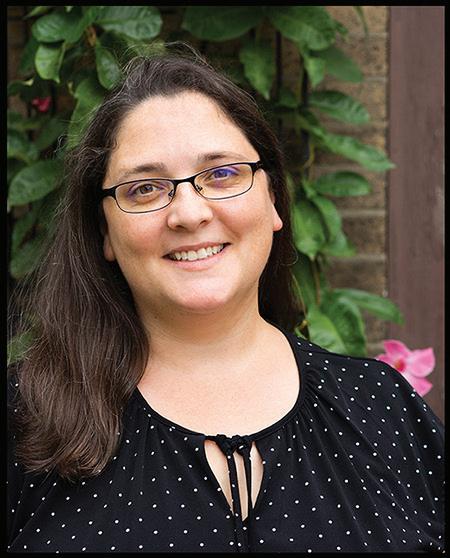
By Amelia Neely BSA Membership & Communications Manager
E-mail: ANeely@ botany.org
• BSA Listening and Discussion Session (March 5, 2025)
• Botany on a Budget (May 8, 2025)
• Careers in Botany: Beyond Academia (June 6, 2025)
• Make the most out of Botany 2025: A student conference guide (June 30, 2025)
• And more to come!
Don’t forget that there are more than 20 recordings available for free to access anytime at https://botany.org/home/resources/ botany360.html

The BSA Spotlight Series highlights early-career and professional scientists in the BSA community and shares both scientific goals and achievements, as well as personal interests of the botanical scientists, so you can get to know your BSA community better.
Here are the latest Spotlights:
• Jeffrey James Keeling, Graduate Student, University of Texas at El Paso https://botany.org/home/careers-jobs/careers-in-botany/bsa-spotlight-series/jeffreyjames-keeling.html
• Aaron Lee, Graduate Student, University of Minnesota https://botany.org/home/careers-jobs/careers-in-botany/bsa-spotlight-series/aaron-lee.html
• Joyce G. Onyendeum, Faculty, New York University https://botany.org/home/careers-jobs/careers-in-botany/bsa-spotlight-series/joyce-gonyenedum.html
Would you like to nominate yourself or another BSA member to be in the Spotlight Series? Fill out this form: https://forms.gle/vivajCaCaqQrDL648.
Do you know a business or organization that would benefit from being in front of over 3000 botanical scientists from over 70 countries, and over 48,500 followers on social media? The BSA Business Office has many opportunities for sponsorship including:
• Sponsored Membership Matters newsletter articles and footer ads
• BSA website banner ads
• Hosting Botany360 events
• Sponsored social media ads
• Advertisement space in the Plant Science Bulletin
• Botany360 event logo advertisement during event, a slide before/after event, or time to discuss product at beginning or end of event
Because we value our community, the above opportunities are limited with the hope of being informative without being intrusive. Sponsorships will allow BSA to fulfill our strategic plan goal of being financially responsible during this time of economic shifts.
To find out more about sponsorship opportunities, email bsa-manager@botany.org.
Thank you to all of our Legacy Society members for supporting BSA by including the Society in your planned giving. We look forward to hosting you at this year’s Legacy Society Reception at Botany 2025 in Palm Springs, CA. If you are interested in joining the Legacy Society, you are welcome to come to the event, scheduled for the evening of July 31, and sign up in person. You can also join the Legacy Society at any time during the year by filling out the form at https://crm.botany. org/civicrm/profile/create?gid=46&reset=1 .
The intent of the BSA’s Legacy Society is to ensure a vibrant scientific Society for tomorrow’s botanists, and to assist all members in providing wisely planned giving options. All that is asked is that you remember the Botanical Society of America as a component in your legacy gifts. It’s that simple—no minimum amount, just a simple promise to remember the Society. We hope this allows all BSA members to play a meaningful part in the Society's future. To learn more about the BSA Legacy Society, and how to join, please visit: https://botany.org/home/membership/thebsa-legacy-society.html.
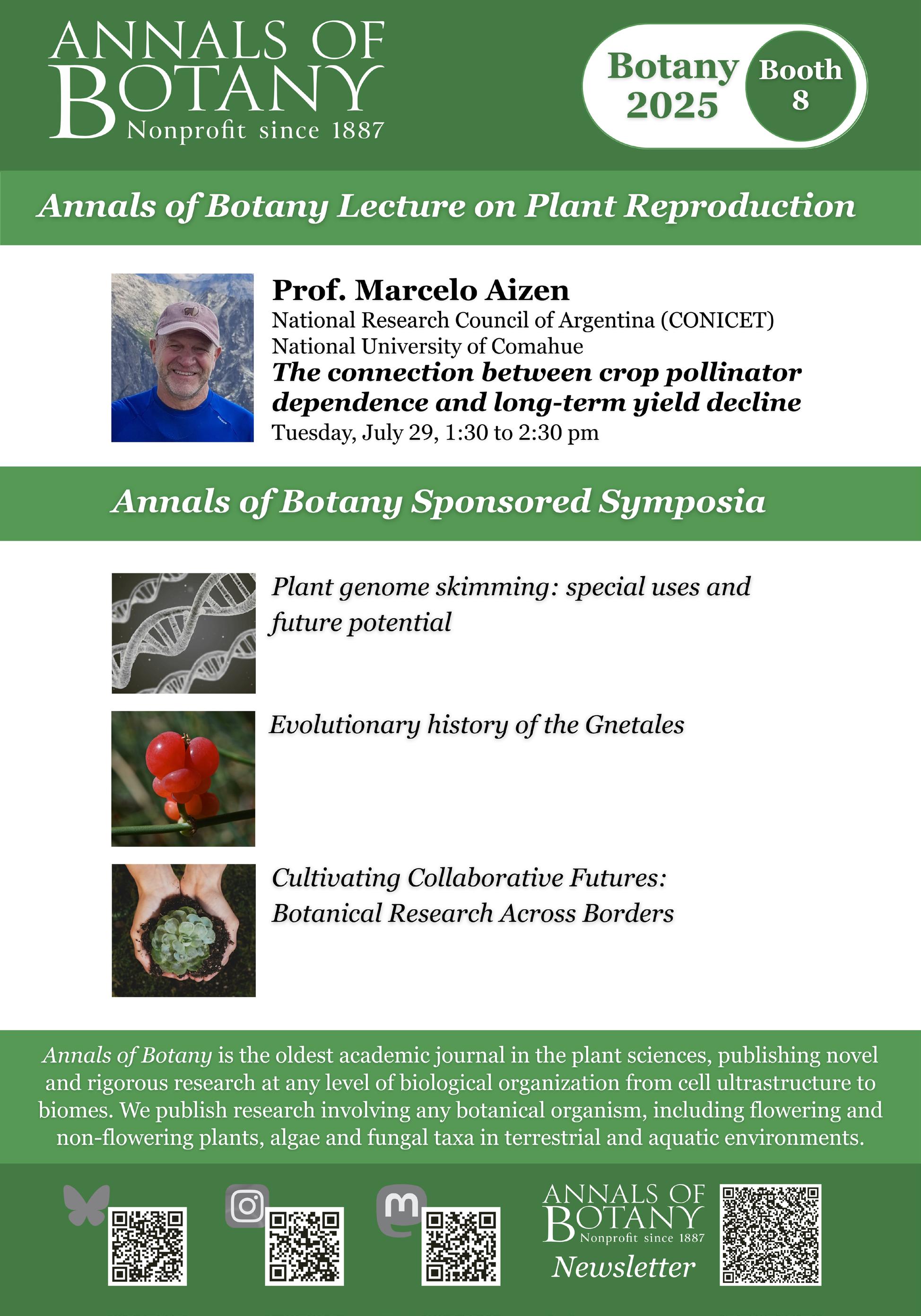


This year marks a special milestone for PlantingScience, a BSA-led educational outreach program that has been inspiring students and supporting science educators for two decades. Since its launch in 2005, PlantingScience has connected middle school, high school, and undergraduate college students with plant scientists in an innovative online mentoring program. Through handson investigations and online conversations


By Dr. Catrina Adams, Education Director Jennifer Hartley, Education Programs Supervisor
with professional scientists, students experience the process of science firsthand while deepening their understanding of and appreciation for the amazing world of plants.
PlantingScience was designed to bring plant scientists into middle- and high-school classrooms so all students have a chance to meet and work with scientists
In 2011, PlantingScience won the SPORE award from the journal Science. The essay “Building Botanical Literacy” (Hemingway et al., 2011; DOI: 10.1126/science.1196979) from that year describes the early history of the program, which was inspired by a 2003 call to action by Bruce Alberts, then president of the National Academy of Sciences, who challenged the BSA to enhance K-12 science classroom experiences. The platform, which
was originally developed and supported in-house by BSA IT Director Rob Brandt, Education Director Claire Hemingway, and Executive Director Bill Dahl, was redeveloped on the HUBzero platform in 2017 (https:// www.rcac.purdue.edu/news/932) to enable larger cohorts, put more tools in the hands of teachers, and enhance the community. Subsequent HUBzero customized updates have improved tools available to participants and streamlined administration and datacuration capabilities (https://www.sdsc.edu/ news/2024/PR20240221_PlantingScience. html). Many of the new features and tools developed for use in PlantingScience have been used by other HUBzero-supported science community hub sites as well.
“I look forward to PS project time every year - it is something that the kids remember and take pride in. Thank you for all that you do! My students loved working with their mentors and hopefully we’ve inspired some future plant scientists!” - PlantingScience teacher
PlantingScience has built a strong community of teachers and scientist mentors who have shared their passion for plants and science with tens of thousands of students
Since its start in 2005, the program has supported over 900 student teams, approximately 36,000 students, and almost 500 teachers. Classrooms in all 50 U.S. states and 9 countries have participated in PlantingScience. Over 1000 plant scientists from 50+ countries have volunteered with the program over the years. The current site’s mentor gallery includes over 700 scientist profiles showcasing the diversity of who plant scientists are and what they do.
In each session, star projects are nominated by mentors, teachers, mentor liaisons, and staff. The best are selected to be shared in the project’s Star Project gallery where they can serve as exemplars and inspire future student teams: https://plantingscience.org/projects/br owse?filterby=archived&featured=1&limit=50
PlantingScience has benefited from generous support from multiple sources
The program has been primarily supported by an $8.35M investment over three National Science Foundation grants from the Division of Research on Learning’s DRK-12 program (DRL 0733280, 2007–2013; DRL 1502892, 2015–2021; DRL 2010556, 2020–2026). This support allowed development and maintenance of the online platform, staff support, research on the effectiveness of the program and student-teacher-scientist partnerships more generally, and professional learning opportunities for teachers and early career scientists.
Generous support from program partners, donors, and sponsors have enabled us to send basic materials to teachers to make the program free to classrooms, and provided prizes to Star Project winners and enabled teacher recruitment (https://plantingscience. org/getinvolved/partners). Partnering scientific societies have provided recruitment and dissemination support, and the American Phytopathological Society (APS), American Society of Agronomy (ASA), American Society of Plant Biologists (ASPB), Canadian Botanical Association (CBA/ABC), Crop Science Society of America (CSSA), Ecological Society of America (ESA), and Soil Science Society of America (SSSA) have joined BSA in supporting the program’s early career scientist liaisons through our Master Plant Science
Program. New module development has also been supported by the American Society of Agronomy (“Agronomy Feeds the World”) and American Phytopathological Society (“Plants Get Sick, Too!”).
“Thanks for the chance to be a liaison again, I’m learning a ton from this experience, from both mentors and their methodology, from students and how they view plants and formulate experiments and the planting science team ability to coordinate something so big each semester and follow through to the end.” - PlantingScience MPST earlycareer liaison
Many, many BSA members and leaders have supported the success of the program by developing, leading, and participating in PlantingScience professional learning with teachers, developing and refining inquiry-based curricular modules on big ideas in plant science, writing support materials, suggesting and testing website improvements, helping teachers to manage mentors, recruiting new mentors, providing financial support, and mentoring students directly.
Research studies show that the program is effective at improving key student outcomes
A number of research studies have been conducted over the years to understand how the PlantingScience student-teacher-scientist partnership program works and to better measure and understand the outcomes of the program. Research has shown that the PlantingScience program can positively affect students’ engagement in inquiry, motivation, and attitudes toward science (Scogin, 2014; Scogin and Stuessy, 2015; Scogin, 2016). A discourse analysis of student-mentor conversations found that online scientist mentors often model for students how scientists integrate
science content and practices in their work (Adams and Hemingway, 2014). A text-based analysis of student responses to an open-ended question found that PlantingScience students most value working with plants, scientist mentors, and having control over their research question (Hemingway et al., 2015). Key insights from previous research highlight the need for professional learning for PlantingScience teachers and mentor liaisons. LeBlanc et al. (2017) found that experienced PlantingScience teachers skillfully talk their students through the inquiry cycle, introducing and emphasizing different science proficiencies at each phase of inquiry. Orchestrating such student experiences requires practice and support. We’ve also learned that differences in the amount, content, and timing of mentoring causes differences in the student experience in PlantingScience (Adams and Hemingway, 2014; Scogin, 2014; Scogin and Stuessy, 2015; Scogin, 2016; Peterson, 2012; Desy et al., 2018).
“[Working] with this team was an incredibly rewarding experience. Not only were they bright, kind, and polite, it was extremely rewarding to see the advice that I was giving them be put to use almost immediately. I loved to see that they readily absorbed and utilized what they learned and that their project turned out to have great results in the end to top it all off.” - PlantingScience mentor
In 2015, BSA was awarded a research grant, “PlantingScience Digging Deeper (DIG),” to conduct a large-scale efficacy study of the program’s Power of Sunlight (photosynthesis and respiration module). Grant partners at BSCS Science Learning helped to develop and deliver collaborative professional learning summer workshops where teachers and early-career scientists could work together to prepare for implementing PlantingScience in
the teachers’ classrooms in fall. Approximately 65 teachers and 3000 students from across the U.S. took part in the randomized control study.
“The more we worked on the projects the more interesting it got. I continued to wonder more and more about plants and had a new question everyday. My mentor constantly asked questions and ideas on how to improve the project. Which kept me more interested throughout the experiment.”
- PlantingScience student
Schools in the study were very similar to the overall U.S. population with respect to student composition. Partners at the University of Colorado Colorado Springs (UCCS) conducted the research analysis and found that students in the PlantingScience treatment group showed greater gains in content knowledge and attitudes about scientists than students in the comparison group (Taylor et al., 2022; Westbrook et al., 2023). The research team produced several videos explaining this study, including quotes from participating teachers and scientists: https://stemforall2017. videohall.com/presentations/922.html ; https://stemforall2018.videohall.com/ presentations/1086.html.
In 2020, BSA received a new research grant, “PlantingScience F2 (F2),” to replicate and extend the results of DIG with a three-arm randomized controlled study to compare the efficacy of online vs. in-person professional learning for teachers and early-career scientists for participation in PlantingScience with students. In addition to studying the impacts of the program on content knowledge and attitudes about scientists, we added an instrument to better understand the program’s impact on students’ interest in studying
plants. We are in the final years of this grant and have just finished data collection and are moving on to analysis, led by the program’s UCCS partners. We intend to have several presentations to share preliminary findings and to get feedback from the PlantingScience community in the next year. Very early results on the impacts of the program on students’ interest in studying plants and how students’ ideas about who scientists are and what they do changed as a result of the mentoring they recieved will be shared at this year’s Botany conference: Monday, July 28, 10:45AM Education and Outreach Paper Session “New Research Supporting the Efficacy of the PlantingScience.org Online Mentoring Program”
As we celebrate the past 20 years of PlantingScience, we’re reminded that the success of this program depends on the support of the incredible community of scientists who make up the BSA and its partners. Thank you to everyone who has shared their time, knowledge, financial support, and passion for plants to support our students! If you’ve never been a mentor, consider joining us and spreading the word to colleagues and friends in the plant sciences. Together, we can cultivate a deeper appreciation for plants in classrooms across the US and around the world. Learn more at www.plantingscience.org.
“[Our mentor] made me have more interest in plants and science because she tells us bout flowers that we didn’t know existed and that shows there is alot more to learn in science.” - PlantingScience student
Adams, C. T., and C. A. Hemingway. 2014. What does online mentorship of secondary science students look like? BioScience 64: 1042–1051.
Desy, E. A., C. T. Adams, T. Mourad, and S. Peterson. 2018. Effect of an online, inquiry- & mentor-based laboratory on science attitudes of students in a concurrent enrollment biology course: The PlantingScience experience. The American Biology Teacher 80: 578–583.
Hemingway, C., W. Dahl, C. Haufler, and C. Stuessy. 2011. Building botanical literacy. Science 331: 1535–1536.
Hemingway, C., C. Adams, and M. Stuhlsatz. 2015. Digital collaborative learning: Identifying what students value. F1000Research 4: 74.
LeBlanc, J. K., B. Cavlazoglu, S. C. Scogin, and C. L. Stuessy. 2017. The art of teacher talk: Examining intersections of the strands of scientific proficiencies and inquiry. International Journal of Education in Mathematics, Science and Technology 5: 171–186.
Peterson, C. A. 2012. Mentored engagement of secondary science students, plant scientists, and teachers in an inquiry-based online learning environment (Doctoral dissertation). Available from ProQuest Dissertations and Theses (Dissertation No. 3532223).
Scogin, S. C. 2014. Motivating learners in
secondary science classrooms: Analysis of a computer-supported, inquiry-based learning environment using self-determination theory (Doctoral Dissertation, Texas A&M University). Available at: https://oaktrust.library.tamu. edu/handle/1969.1/153419
Scogin, S. C., and C. L. Stuessy. 2015. Encouraging greater student inquiry engagement in science through motivational support by online scientist-mentors. Science Education 99: 312–349.
Scogin, S. C. 2016. Identifying the factors leading to success: How an innovative science curriculum cultivates student motivation. Journal of Science Education and Technology 25: 375–393.
Taylor, J., C. T. Adams, A. Westbrook, J. Creasap-Gee, J. K. Spybrook, S. M. Kowalski, A. L. Gardner, and M. Bloom. 2022. The effect of participation in a student-scientist partnership-based online plant science mentoring community on high school students’ science achievement and attitudes about scientists. Journal of Research in Science Teaching 59: 423-457.
Westbrook, A., C. Adams, and J. A. Taylor. 2023. Digging Deeper into Student-TeacherScientist Partnerships for Improving Student Achievement and Attitudes about Scientists. American Biology Teacher 85: 378-389.

The Master Plant Science Team (MPST) is a unique opportunity for early-career scientists to make a lasting impact on 6th- to 12th-grade science education! As part of the MPST, you’ll provide essential support to teachers as they bring PlantingScience into their classrooms. MPST members share their expertise, facilitate communication between teachers and their students’ mentors, and moderate online student-scientist conversations to ensure students get the most out of the experience! It’s a rewarding way to grow your science communication and leadership skills, connect with a national network of educators and scientists, and champion the next generation of plant thinkers. Learn more (and apply) at https://plantingscience.org/getinvolved/ joinmpst.
The ROOT&SHOOT National Science Foundation Research Coordination Network, a collaboration of six plant science organizations including the BSA, has sponsored a student-organized, free online seminar series titled “Cultivating a Culture of Inclusive Excellence in Plant Sciences.”
The series has included four talks so far in 2025. The first, “Perspectives from Black
Professionals in the Plant Sciences,” held on February 25, featured guest speakers Dr. Margaret Young (Elizabeth City State University) Dr. Stephon Fitzpatrick (Together We Grow & National MANRRS President), and Dr. Jason B. Thomas (The Pennycress Company) (available at: https://rootandshoot. org/root-shoot-webinar-perspectives-fromblack-professionals-in-the-plant-sciences/ ).
The second seminar, titled “Radicle Science: A Teach-In for Plant Scientists Organizing for Political Impact” was held on March 25 with speaker Dr. Kevin Bird, who led a discussion on plant scientists’ involvement in politics throughout history, and how attendees can play a role in today’s political landscape (available at: https://rootandshoot.org/ateach-in-for-plant-scientists-organizing-forpolitical-impact/). The third seminar, held May 13, featured BSA Education Committee member Dr. Molly Edwards from Science IRL Productions, who presented on “Planting the Seeds of Change: Communicating Science with Purpose.” Tips on making short, impactful videos that stand up for science were shared at the webinar (available at: https://rootandshoot. org/make-a-video-that-roots-for-sciencewith-molly-edwards/), and participants were encouraged to share their videos starting June 23 using the hashtag #RootingForScience. The fourth seminar, held July 3, featured Dr. Guadalupe Maldonado Andrade (Cal Poly Pomona) speaking on “What Grows in the Margins: Plants, People, and the Politics of Care.” The talk wove together Dr. Andrade’s work as an ethnobotanist and abortion doula to explore the intimate and political relationships between plants and reproductive care, and examined what it means to center care in scientific inquiry and academic practice (available at: https://rootandshoot. org/webinar-plants-people-and-the-politicsof-care/).
For more information on upcoming seminars in this series, check the rootandshoot.org website or sign up for the mailing list here: https://forms.gle/dJdxuZQjRDBF1Qn26
The ROOT&SHOOT Research Coordination Network (RCN) is developing a free, online mentoring training designed to help plant scientists become more effective mentors by addressing the role social identity plays in mentoring relationships. See Me Mentoring Training (Social Identity Matters in Mentoring), is a collaborative effort created by a diverse group of plant scientists from various career stages, in partnership with mentoring experts from CIMER (cimerproject.org). The goal of developing this independent online program is so that all plant biologists can engage with the training without charge.
Before the official launch, the program is seeking a small group of volunteers to participate in a beta test and provide feedback. The pilot includes pre-training independent
work followed by six weekly 90-minute online small-group facilitated sessions. Beta-testers will be asked to complete short post-session surveys and participate in a final group evaluation. The training will span seven weeks, from September to early November, and will cover essential topics such as color-evasive practices in academia, engaging in impactful mentor-mentee conversations, shifting from a deficit-based to an asset-based mindset, intersectionality, and developing greater cultural awareness.
Volunteers who participate in the beta test may receive a small honorarium, though this is not guaranteed due to ongoing funding uncertainties. The team is particularly interested in recruiting individuals who recognize the value of this work and are willing to take part regardless of financial compensation. To express your interest in volunteering as a beta-tester, please complete the sign-up form by August 1, 2025: https:// docs.google.com/forms/d/e/1FAIpQLSc-uNc SgYplGmFo8hzSLX7btPDdqm2gPLokSBIz68 IIKyFvLg/viewform?usp=header
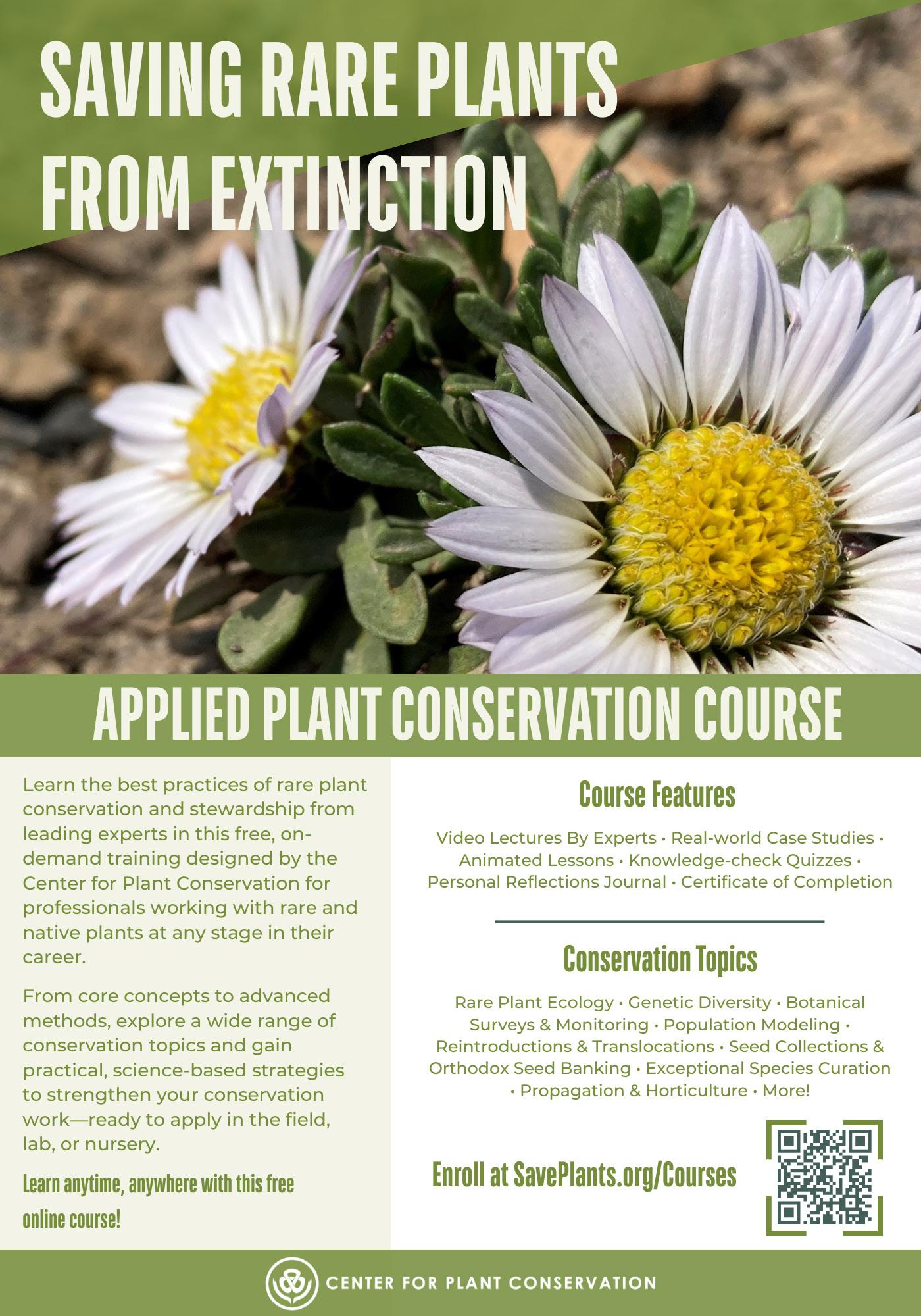

We are excited to welcome our incoming BSA Student Rep, Sara Pedraza. Sara’s term will begin the day after the Botany conference and will last for two years from 2025 to 2027. Get to know her in the interview below.

Sara Pedraza Ph.D. Candidate at University of California, Los Angeles


By Josh Felton and Benjamin Aderemi Ajayi BSA Student Representatives
When did you join BSA and what motivated you to do so? Will you encourage other students to become members and participate in the Society as well?
I joined BSA two years ago after learning about the Society during a lab meeting. As an international student, I was eager to connect with scientific communities in the U.S. that could support my academic development and help me build connections within the field. One of the main reasons I was drawn to BSA is that it’s one of the few scientific societies that still offers funding opportunities for international students. I highly encourage students to join BSA and take advantage of the many benefits it offers!
What motivated you to run for the position of Student Representative to the Board of Directors and what do you plan to do as the student representative of BSA?
From the very beginning of my scientific career, I recognized the value of having a supportive community. During my Ph.D., researchers and mentors in both Colombia and the U.S. have been crucial in helping me advance my project and grow as a scientist. I believe botany has a unique ability to bring people together (everyone loves flowers and plants!), and I am committed to fostering that sense of community within BSA. Botany has profoundly shaped my life, allowing me to explore nature and the world through
research. This journey has been made possible by the generosity of academic institutions and research organizations that support passionate scientists like me, as well as through meaningful collaborations. As a member of the BSA Board, I am committed to promoting curiosity, integrity, collaboration, and fairness among BSA members. I am confident that by prioritizing these values, we can cultivate a more inclusive and diverse scientific community—ultimately strengthening both our Society and the field of botany.
What have you gained from being a student member of BSA and why would you encourage other students to become members and participate in the Society?
The main contribution has been gaining access to a wide variety of resources that have helped me advance in my career. For example, American Journal of Botany is an essential source of information for botany students. Being part of this community has also fostered a sense of belonging within the scientific community in the U.S., something that can be difficult to develop as an international student. Also, I was recently awarded a BSA grant, which has significantly supported my research and, in turn, my professional development.
What’s your research about and how did you discover your research interest?
I am broadly interested in the evolution and performance of tropical plants. My research explores how variation in plant thermal capacities across elevations and mountain ranges influences diversification. I was born in the tropics (Bogota, Colombia), a region with extraordinary plant diversity. Since childhood, I have been fascinated by life, biodiversity, and how nature works. At the same time, I’ve always aspired to contribute not only high-quality scientific knowledge but also information that benefits the communities I belong to. Growing up in the mountains, my identity as a Latin American woman in science deeply motivates my passion for studying the thermal physiology and genetics of tropical plants in the Colombian Andes. I believe that being personally connected to my research (both scientifically and culturally) profoundly shapes my approach to science and my role as a researcher.
What sorts of hobbies do you have?
I love cooking, especially “arepas” and other kinds of Colombian food. I also enjoy art and dancing. Spending time with friends over a good cup of coffee (I’m Colombian!) is one of my favorite things. I really enjoy hiking and being outdoors—I love nature, from the beach to the mountains, and I’m always excited to explore new places around the world. I also enjoy watching soccer, especially when my team is playing!
We are excited to see many of you in person at Botany 2025 in Palm Springs! As of June 30, 2025, there are 508 students registered! Please do not be a stranger at the conference—come up and say hi if you see us!
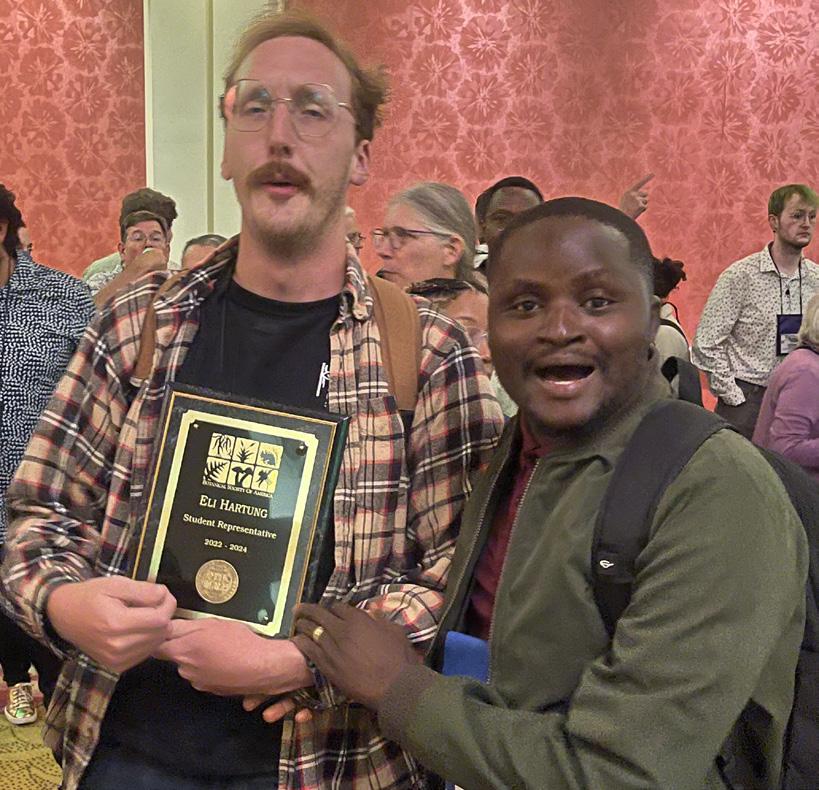
Eli (student rep 2023-2025) passing his wisdom with some cheeky wit to Ben last year in Grand Rapids.
At the Careers in Botany Luncheon, we will have 10 panelists who will represent the spectrum of career stages and jobs, with panelists working in academia, government, non-governmental organizations, herbaria, and botanical stations. New this year, we will add in a section at the end of the luncheon to allow for a larger group share out to make sure insights and advice are heard regardless of if the student was at that table. This will allow us to make it so that students will be able to connect with the variety of careers (senior and junior faculty at R1 and PUI, industry and botanic gardens). Ninety-five students will be gain insights from our panelists:
Adam Healey
Research Scientist - Genome Sequencing Center
HudsonAlpha Institute for Biotechnology
Israel Borokini
Assistant Professor
Montana State University, Bozeman
Jessica Guo
Assistant Professor
Harvey Mudd College
Ashley Kass
Education Researcher and Project Manager
Education Research and Outreach Lab
Donald Danforth Plant Science Center
Sterling Herron
Research Assistant V Archbold Station
Dr. Tia-Lynn Ashman
Distinguished Professor of Biological Sciences, University of Pittsburgh, Pittsburgh PA
Dr. Jeremie Fant
Director of Conservation
Chicago Botanic Garden
Dr. Elizabeth Mccarthy
Assistant Professor
SUNY Cortland
Dr. Matthew Austin
Assistant Curator of Biodiversity Data
Missouri Botanical Garden
Dr. Susan Pell
Executive Director
United States Botanic Garden
At Botany 2025, the Early Career Professional Development Committee is hosting a listening session to support students and early career professionals on Wednesday July 30 from 2 to 3 pm. During the session, we will provide a dedicated space for early career botanists to share their concerns, questions, and ideas about the state of academia and the botanical sciences.
Our goal for the session is to serve as both a listening forum and an opportunity to foster community among early career attendees. Insights gathered will guide future programming and support efforts led by the committee.
Learn more about the committee here: https:// cms.botany.org/home/governance/earlycareer-committee.html
Students, please do not hesitate to reach out to us by email or BlueSky @ botanyballer.bsky.social & @ajayibenmi. bsky.social or via email feltonjosh@icloud. com & aderemibenjamin@gmail.com


GEORGE SCHATZ
George Edward Schatz of Ringoes, New Jersey, and St. Louis, Missouri, passed away in November 2024. George was an explorer, scientist, conservationist, lover of trees, and advocate for tropical biodiversity.
Born in Pittsburgh, Pennsylvania, in 1953, he was the son of Edward Ralph Schatz and Virginia Wright Schatz and the younger brother of Eleanor Louise Magyar (Schatz). George was a graduate of Phillips Academy in Andover, Massachusetts, studied plant sciences at Cornell University, and received a PhD in Botany from the University of Wisconsin in 1987.
At the University of Wisconsin, he studied the systematics and ecology of Central American Annonaceae (the custard apple family). The year he received his degree, George joined the staff of the Missouri Botanical Garden, where he spent his entire career. He was hired to help build the Garden’s program in Madagascar. He resided there for several years and then divided his time between Madagascar and St. Louis, conducting field and herbarium work, and helping to train Malagasy botanists and build the program into one of the most impactful research and conservation efforts in the world.
George focused his fieldwork on the island’s humid forests and quickly became a leading authority on the flora of the island, publishing his seminal Generic Tree Flora of Madagascar in 2001, a guide to the nearly 500 genera of trees occurring there, which quickly became a key reference work. He made nearly 3200 meticulously prepared collections of Malagasy plants, including specimens of many new species, more than 30 of which have been named in his honor.
As a taxonomist, George named more than 300 species belonging to 39 genera in 20 families, including 216 species new to science. Throughout his career, George continued to work on Annonaceae, recently completing a treatment for Flora Mesoamericana, which will be published shortly.
Starting in the late 1990s, in collaboration with his colleague Pete Lowry, George initiated a series of taxonomic revisions of Madagascar’s endemic families, and in
2009 they undertook a collaborative effort to untangle Malagasy ebonies (Diospyros), the island’s largest woody genus, with close to 300 species—more than two-thirds new.
As the Madagascar program grew to include a major conservation component, George championed the effort to assess the extinction risk of species using the IUCN Red List criteria, and he served for many years on the IUCN SSC Plant Conservation Committee, organizing and leading training workshops throughout the world for hundreds of botanists.
George is survived by his wife, Cathryn Goodwin; his daughter, Rachel Schatz (Alec Hillyer); his three stepchildren, Joshua (Melissa) Gaghen, Elijah (Abby) Gaghen, Emily (Adam) Elsey; six grandchildren, Grace and Lily Gaghen, Ellasyn and Will Gaghen, Abram and Alice Elsey; and his niece, Rebecca Magyar.
—Compiled by Amy McPherson

Since 1875, the International Journal of Plant Sciences (IJPS) has presented high-quality, original, peerreviewed research from laboratories around the world and in all areas of the plant sciences. Topics covered include genetics and genomics, developmental and cell biology, biochemistry and physiology, morphology and anatomy, systematics, evolution, paleobotany, plant-microbe interactions, and ecology. IJPS welcomes research articles that describe novel results and new perspectives on topics of interest to the international community of plant scientists. e journal also features reviews and special issues in growing areas of the eld.
IJPS has been publishing high-quality, original, peer reviewed research in all areas of the plant sciences since 1875.
IJPS editors are leaders in the eld and guarantee integrity by handling each paper from beginning to end, writing their own decisions and adding their imprimatur to each article.
ere are no submission fees or page charges. Each manuscript is entirely free, no matter the size.
Color gures that make substantive contributions to the article are printed at no cost to authors.
IJPS has one of the most a ordable options for Open Access: as low as $400 for authors at subscribing institutions.
Manuscripts that have been rejected from other journals can be eligible for expedited publication when prior reviews and decision letters are included in the submission.
All articles in each issue are eligible to be featured on the cover at no cost to the author(s).
Two authors from each article are granted complimentary 1-year subscriptions to IJPS
IJPS is owned by the University of Chicago Press, which places publishing before pro t.





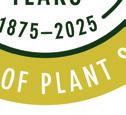


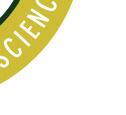

Do Plants Know Math? Unwinding the Story of Plant Spirals, from Leonardo da Vinci to Now
Edible Alliums: Botany, Production and Uses
Evolution Evolving: The Developmental Origins of Adaptation and Biodiversity
From Seed to Seed: A Pictorial Story Showing How a Bean Plant Grows
History and Future of Plants, Planet and People: Towards a New Ecologically Sustainable Age in People’s Relationships with Plants
Legumes of Arizona: An Illustrated Flora and Reference
Living with the Trees of Life: A Practical Guide to Rebooting the Planet Through Tropical Agriculture and Putting Farmers First (ed 2)
Malayan Orchid Review 2024 Annual, Volume 58
Oak Origins: From Acorns to Species and the Tree of Life
Saving Orchids: Stories of Species Survival in a Changing World
A Splendour of Succulents & Cacti
Tropical Arctic: Lost Plants, Future Climates, and the Discovery of Ancient Greenland 1
When the Earth Was Green
Do Plants Know Math? Unwinding the Story of Plant Spirals, from Leonardo da Vinci to Now
Stéphane Douady, Jacques Dumais, Christophe Golé, and Nancy Pick 2024. ISBN: 9780691158655
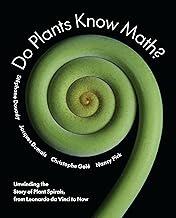
US$27.95 (Hardcover); 338 pp. Princeton University Press, Princeton and Oxford.
This gem of a little book links history to math, physics and botanical knowledge in delightful and inciteful wonderment!
Count the syllables and look for the pattern in the poem above. This Fibonacci sequence is modelled on Sanskrit poetry contemporaneous (ca. 300 BCE) with Theophrastus’ observation that leaves are
arranged in regular sequence along a stem. A similar poem introduces the main themes of most of the book’s 21 chapters. The powers of observation and documentation are stressed throughout the book with interesting narratives about the key players, exquisite copies of illustrations and stunning original images. The authors emphasize that science is often “messy”, not a linear accumulation of knowledge, and that scientists are human, they frequently squabble, and often rediscover what had been discovered long ago.
“The quest to understand why the Fibonacci numbers appear in plants is an eminently satisfying one, located at the intersection of math, physics, and biology”—the respective disciplines of the first three authors.
The introduction provides clear, illustrated definitions of 10 key terms used in phyllotactic analysis that would be a perfect hand-out for students. It ends with several engaging “Try Your Hand” activities: how to use your smartphone to draw parastichies on a photo
of a dahlia or pinecone; how to pin spirals on a pineapple; and how to unroll a 3D pinecone onto a sheet of dough or clay to produce a 2D pattern to trace and count parastichies. Similar activities reinforce the salient concepts of most chapters.
The book is divided into four content sections each focusing on a key step in understanding phyllotactic patterns. The first is simply “Who noticed first?” Natural patterns in plant life are documented in many ancient civilizations, but it was Leonardo de Pisa (Fibonacci) who introduced the power of Arabic numerals and the Fibonacci sequence to Europe in 1202. Two hundred fifty years later, another Leonardo—da Vinci—made detailed sketches and observations on patterns of leaf and branch insertion, including a 2/5 spiral, distichous, and decussate patterns. In another 150 years Keppler at least popularized the concept that the Fibonacci ratios converge on the “golden mean”, 1.618….
Part Two focuses on the traditional history of phyllotaxis theory, including the works of Karl Schimper, who coined the terms “phyllotaxis” and “divergence angle,” and Alexander Braun, who coined “parastichy” and what we now call “orthostichies.” Although best friends and colleagues when they developed their ideas, they became estranged when Shimper, who seldom published any of this work, felt he did not receive enough credit from Braun when the latter published his monumental study of pinecone scales. Concurrently in France, Auguste and Louis Bravais confirmed and extended the Germans’ phyllotactic descriptions with a mathematical proof of the value of the golden angle, (3-✓5)/2 in units of turns around the stem, and the observation that even orthostichies slowly spiral around the stem.
Part Three introduces microscopic studies of the apical meristem, beginning with the observations of Wilhelm Hofmeister. I was pleasantly surprised with the authors’ contention that “Hofmeister’s rule,” the stacking principle that primordia are initiated in the first available space on the apical meristem, is the first of three criteria explaining the physics of phyllotaxy. In fact, Hofmeister dismissed all the earlier work on spirals as not only inappropriate, but in error! I am not alone in my previous lack of appreciation for Hofmeister’s role in understanding the basis of phyllotaxy. Of the 44 authors providing 34 contributions to the monumental Symmetry in Plants (Jean and Barabé, 1998), only five include Hofmeister in their references (and Douady is author or co-author of two of these).
Part Four focuses on the contribution of computers and modeling. Not only could Hofmeister’s rule be confirmed for where a primordium could form to establish and maintain a pattern, but it also allowed development to be considered to confirm Snow and Snow’s model that a primordium will be produced when there is enough space. The timing depends on the rate of expansion of the apical meristem and the rate of primordium initiation. The one missing parameter was the history of growth. For nearly as long as patterns have been observed, botanists recognized that the pattern along the axis can change, but almost always from one set of Fibonacci numbers to the next, up or down in the sequence. Douady was involved in demonstrating how these parameters work together in the plant, but it remained for Golé to recognize “zigzag” fronts of the youngest primordia on the apical meristem and realize this determines the transition and direction of phyllotactic changes along the stem.
The fifth part integrates biology into the mathematical and physical explanations for phyllotaxy. The concept of inhibitory fields at the apical meristem was proposed by Schoute in the early 1900s. After World War II, Alan Turing programed a computer to produce a regular pattern, beginning with randomized activator and inhibitor sequences. If auxin is the activator, and it is depleted by diffusion (or active transport), phyllotactic patterns of leaf primoridia form on an apical meristem.
So, the bottom line is, do plants know math? The authors answer “they don’t have to.” The Fibonacci patterns arise from morphogenesis, created by local biochemical, biomechanical, and dynamical mechanisms following simple geometric rules. At this point you can celebrate your newfound understanding with a celebratory “Spiral Dinner” using the recipes provided in the final chapter.
The book has a comprehensive index and extensive endnotes to each chapter. A useful appendix provides additional historical notes for several chapters, and more detailed examples and explanations to supplement the more mathematical chapters. It is beautifully illustrated, clearly organized, and accessibly written. I am recommending it to my local public library; the catchy title will attract plant lovers and perhaps inspire them to think more about science. Elementary teachers will find it to be a resource for plant-related activities involving math, science, and art. School libraries should also have a copy—both secondary and post-secondary. It could even provide the foundation for graduate seminars in math, physics, biology, and history of science. It is arguably the most welcome addition to my personal library in the past decade.
Jean, R. V., and D. Barabé. 1998. Symmetry in Plants. World Scientific Co. Pte. Ltd. Singapore.
–Marshall D. Sundberg. Kansas University Affiliate and Roe R. Cross Distinguished Professor of Biology – Emeritus, Emporia State University.
Haim D. Rabinowitch and Brian Thomas (Editors) 2022. ISBN: 978-1789249972
US$161.20 (Hardcover); 328 pp. CABI Publishing, Oxfordshire, U.K.
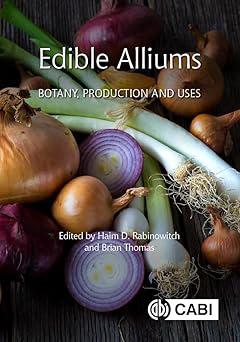
We have been eating, growing, harvesting, and using the Allium species as medicine for over a millennium. From the onion to shallot bulb, to garlic cloves, to leeks and green (bunching) onions, the Alliums are integral to local diets worldwide. They are quite hardy and are cultivated and harvested in a range of climatic conditions all over the world. As members of the Amaryllidaceae family, Alliums belong to the order Asparagales. Appearing during the early Eocene period, about 52 million years ago, the species originated on the subcontinent of India. They spread all through North America and Eurasia about 10 to 20 million years ago, during the middle Miocene period (p. 20).
According to Kew Science of the Royal Botanical Gardens, the Allium genus comprises 2140 species, 70 of which are cultivated as spices, vegetables, or ornamentals species, with garlic, onions, leeks, shallots, green onions, and chives being of great economic
importance (p. 20). We can eat every part of the Allium species. From the scapes that sit atop maturing garlic plants, to the lateral leaves of leeks, to the onion bulb, this species can be used to make stock, to season soups and stir fries, and to adorn salads. Contributing author Nikolai Friesen notes that while many species do taste mighty fine, there are some that are unpalatable and less consumable. Alliums of the subgenus Nectaroscordum, for instance, taste and smell like burnt rubber (p. 6).
Edible Alliums: Botany, Production and Uses offers readers a thorough scientific and horticultural review of the minor and major Allium crops. Students in plant science, agriculturalists, molecular biologists, agronomists, and garlic-loving gardeners will find that Edible Alliums provides indispensable, well-researched information about the Allium species and their biodiversity, taxonomy, agronomy and production, crop protection, trait genetics, and nutritional and health benefits. Various figures clearly outline useful information about the differences between bolter, semi-bolter, and non-bolter garlics (p. 93), the similarities between the architecture of an onion and shallot bulb (p. 69), and enzyme steps that are required to synthesize fructans from sucrose in the onion (p. 60). Tables show comparisons of long- and shortday varieties with respect to tissue-selective genes (p. 59), provide details about the main bacterial diseases affecting the bulb onion (p. 229), and outline the health benefits of allium extract, replete with brief descriptions of its application and function (p. 273).
For those scientists interested in omics research, the chapter “Metabolomics of the Allium” reviews the published literature in this area, noting the methods that scientists have used to isolate, extract, and characterize many of the secondary small molecules of the
species (p. 270). Metabolomics is the study of the chemical process of metabolites found inside cells, tissues, and organisms—a process that contributes to the plant physiology of the species and is also responsible for traits such as color, pungency, and flavor. For instance, omics research tells us that the shallot bulb is richer in fats, containing 16% to 33% more soluble solids (such as the carbohydrates fructans, fructose, glucose, and sucrose) compared to the 7% to 15% found in bulb onions (p. 76). It also tells us that the the alliin present in the bulb is catalyzed by the enzyme alliinase to produce allicin, and this creates the aroma we smell after crushing a garlic clove.
Metabolomics can also improve crop production with useful information about plant physiology for cultivating Allium varieties that are more crop resistant to diseases, such as botrytis leaf blight, downy mildew, and white rot. As the climate continues to change, metabolomics can also improve the species’ ability to withstand drought conditions. In that regard, the metabolite fructan helps garlic, for example, to withstand drought stress. Fructan is stored as a carbohydrate and facilitates water retention by acting as a sort of spacer to stabilize the cell membrane and maintain osmotic balance. More importantly, given the many medicinal uses of the species, continued research into the metabolomics of Alliums could lead to new developments in cancer medicine, nutritional diseases, and pharmaceutical uses (p. 270).
Readers might be surprised to learn that, despite its ubiquity in the world and in our kitchens, much more research needs to be conducted in terms of cataloging Allium biodiversity. While the World Database on Protected Areas has been established to “identify, rescue, preserve, manage, and study Plant (PGR) and Animal (AGR) Genetic
Resources” (p. 21), contributing authors Andrés Bermudez et al. note that there are still countries that cannot afford the costs of doing this important work. In order to foster the collection and cataloguing of Allium biodiversity, Bermudez and colleagues believe that “new expeditions must be made to search for wild and cultivated varieties” (p. 29). It is hoped that such endeavors will discover cultivated and wild varieties that may better tolerate pests and diseases and may also be better adapted to climate change (p. 29).
Like CABI’s other series titles, The Avocado and The Coconut, Edible Alliums is a useful reference resource. For those with a love for all things Allium, particularly those who are interested in genomic resources of the species, their genetic traits and biodiversity, and their metabolomics, this book is worth having on the shelf.
–Rachel Burgess, Independent Scholar, Rochester, NY 14606; rachel.burgess.ph.d@gmail.com
Kevin N. Lala, Tobias Uller, Nathalie Feiner, Marcus W. Feldman, and Scott F. Gilbert 2024. ISBN: 978-0-691-26241-3 US$45.00 (Hardcover); 426 pp. Princeton University Press, Princeton and Oxford.

The title implies two things: (1) the evolutionary process continues to evolve over time, and (2) a new way of explaining this evolution, focused on development, has emerged. To many, “nothing in biology makes sense anymore” because virtually all the tenets of the “Modern Synthesis” are being challenged and expanded by the
many, integrated developmental mechanisms documented in this book. The book is divided into four parts.
The first four chapters, Part 1, address the question of why development is an important consideration for understanding evolution. The authors begin by summarizing the major tenets of Natural Selection codified in the Modern Synthesis (variation, differential fitness, selection, and heredity) and explaining why the study of development and the importance of phenotype, growing in parallel with evolution, were ignored as contributing factors for much of the 20th century. During this comparison they provide several examples that challenged adaptationist thinking and are the focus of later chapters.
The two chapters of Part 2 explain the biology of how development works. It begins with the discussion of a life cycle with the zygote not being the starting point of the individual, but a point on a long continuum down generations. The authors argue that the genome is a “score to be interpreted” rather than a “code to be deciphered” (p. 28).
The focus is on gene regulation, not just through enhancing or silencing transcription factors, but through Gene regulatory networks (GRNs), which combine genetic regulation with non-genetic and environmental factors. Regulation is a circuit-like network where nodes can be transcription factors, epigenetic elements, small RNAs, and other effector molecules. GRNs are organized into complex modules where phenotypes depend on where and when mutations, epigenetic factors, and physical or chemical forces occur. Each GRN can have multiple functions in different tissues to control the location, timing, and amount of gene expression. Development is both active and reactive, and there can be multiple
pathways to a given phenotype. Finally, development biases phenotypic variation.
Part 3 is the heart of the book with five chapters, each devoted to arguing for a foundational concept underpinning the developmental basis of the evolutionary process. The first is developmental bias. Darwin first recognized “domestication suites” of characters commonly found in domesticated species. The authors explain these suites as one example of developmental bias. This is different from an evolutionary geneticist’s concept of developmental constraint because it is often positive, causing certain phenotypes to more likely be generated—similar to bias in codons for a particular amino acid. Gould’s thought experiment to “replay the tape [of evolution] a million times…” (Gould, 1989, p. 289) would, because of developmental bias, likely result in multiple near-identical patterns. Similarly, co-option of existing GRNs is highly likely and would explain why parallel evolution is so common. Importantly, none of this would require changes in gene frequencies, the traditional marker of evolution.
Phenotypic plasticity, they argue, is another bias that can be adaptive or not. Novel environmentally induced variants can become fixed or stabilized, and this would happen not in a single individual, but simultaneously in multiple individuals in a population. Not only would this allow cryptic genes to accumulate but it would accommodate further adaptation to more and different new environments resulting in adaptive radiation. Plasticity can also lead to niche construction, such as allelopathy, learning, and behavior.
In addition to its effects on variation, the authors argue that development also impacts selection. Selection is usually considered
a consequence, e.g., an organism with an appropriate suite of adaptations is more likely to survive a challenging environment. But the challenging environment can also positively select variants that create a physiological solution or suitably modify their niche through a kind of trial-and-error process.
Up to this point in the book, epigenetic control of development has been a main focus, but Chapter 10 introduces some additional extragenetic inheritance, such as paternal effects, inherited microbiomes, and particularly in animals, learning and culture. The final part discusses some of the implications of the developmental perspective. Of particular interest to many readers will be the penultimate chapter, which focuses specifically on human evolution.
The book makes a strong case that developmental plasticity generates novel structures and processes, with endless flexibility to integrate with environmental changes. Temperature, pressure, chemicals, material properties all bias formation of developmental pathways and once a pathway exists, it can be coopted and reused as required. Not only does evolvability evolve, but because of the various developmental biases, it is more predictable than expected.
The authors weave into the text a salient history of evolutionary biology and have done a good job of explaining many recent technological advancements and theories in terms that any scientifically literate person can understand. They have made clear contrasts of their expansion of the Modern Synthesis of Evolutionary Biology with the traditional views, and use many examples, including some plants (although I would have preferred more botanical examples), to illustrate their
explanations. There are extensive endnotes to each chapter and a comprehensive list of references. The index is very useful. It would be a great book to spend a semester picking apart in a graduate seminar, especially if co-led by a population geneticist and developmental biologist (having two professors thoughtfully arguing alternative explanations in the same class is mind-opening for most students). Evolution Evolving definitely belongs in college libraries and on the bookshelf of any biologist interested in evolution.
Gould, S. J. 1989. Wonderful Life: The Burgess Shale and the Nature of History. W. W. Norton and Company, New York.
–Marshall D. Sundberg. Kansas University Affiliate and Roe R. Cross Distinguished Professor of Biology – Emeritus, Emporia State University.
From Seed to Seed: A Pictorial Story Showing How a Bean Plant Grows
Ellen T. Paparozzi, Elizabeth Conley, M.S., and Christian G. Elowsky 2024.
Department of Agronomy and Horticulture at the University of Nebraska
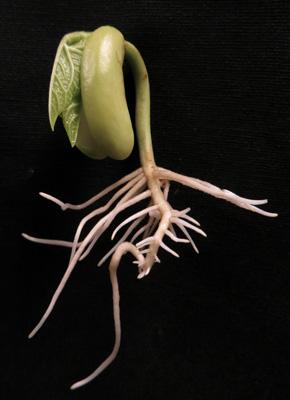
Online resource available at https://passel2.unl.edu/.
Seed germination is a crucial biological process that initiates a plant’s life cycle, transitioning the seed from dormancy into thriving seedlings and eventually to a fully grown plant. In the book From Seed to Seed: A Pictorial Story Showing How a Bean Plant Grows, Paparozzi et al. provide an in-depth examination of this process, presenting a detailed timeline of the development of the red kidney bean from imbibition to the
production of seeds, completing the plant life cycle. The comprehensive narrative is enriched with precise botanical descriptions and detailed illustrations, making the book an exceptional resource for understanding the complexities of seed germination.
There are numerous resources available on seed germination; however, many of them are limited in terms of access, quality pictures, and precise botanical descriptions. In the book From Seed to Seed the authors skillfully address the multifaceted stages of germination by dividing the book into three parts. Part 1 covers germination and vegetative growth, incorporating a growth-time table (Part 1, p. 3) that charts the development of the red kidney bean from day 0 to 75. This chronological framework provides an invaluable reference for students and educators, supporting classroom activities. Part 2 dives into the flowering stage, elucidating the progression from vegetative to reproductive phases with clarity and precision. Similarly, Part 3 highlights the practical applications of the subject, offering straightforward protocols for optimal growth conditions and classroom demonstrations, making it highly adaptable for teaching at both school and college levels. The initial overview presented in the book provides a concise yet informative description of the bean plant's morphology, offering readers an opportunity to refresh their understanding of its distinctive leaf structure. The inclusion of a detailed time chart not only serves as an excellent visual aid, but also establishes a practical framework for organizing various classroom activities focused on seed germination.
Illustrations in the book are particularly noteworthy. Each stage of development is accompanied by high-resolution photographs and micrographs, including scanning electron micrographs (e.g., Fig. 59, p. 26), which
accurately illustrate anatomical structures such as vascular tissues within the stem. Additionally, light microscopy images of stained cross-sections (e.g., Fig. 70, p. 37) further enrich the content, facilitating the identification of key tissue types. Additionally, the labeling of figures, supported by self-explanatory legends, enhances the comprehensibility of the material for both novice and advanced readers. Furthermore, the text provides botanical insights into the unique morphology of the red kidney bean, a model species widely used in studies of seed germination. The authors introduce readers to critical concepts, including the structural changes occurring during the entire process. These aspects are seamlessly integrated with practical examples, bridging the gap between theoretical knowledge and real-world applications in agriculture, horticulture, and ecology.
Overall, From Seed to Seed is a well-crafted resource that combines botanical precision with understandable language and visually appealing content. It holds significant value for introductory botany courses, advanced research in plant sciences, and outreach to citizen scientists. By providing a thorough yet approachable exploration of seed germination, this book serves as a vital tool for both education and research, including botanists, horticulturists, and citizen scientists.
–Sasmita Mishra, Department of Biological Sciences, Kean University, Union, NJ, USA; samishra@kean.edu
and People: Towards a New Ecologically Sustainable Age in People’s Relationships with Plants
Alan Hamilton and Pei Shengji
2024. ISBN: 9781789248920
US$155.00 (hard cover); 417 pp.
CABI, Boston, MA
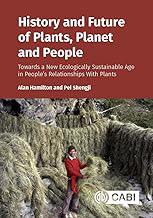
Both authors are trained in traditional botany—Hamilton at Cambridge in the early 1960s, and Shengji at the Kunming Institute of Botany, Chinese Academy of Sciences in the mid-1950s. Both worked extensively in the tropics, with Hamilton primarily in Africa, but also Mexico, Pakistan, Nepal, and Malaysia, and with Shengji in south China. Both specialized in ethnobotany, particularly on traditional knowledge and uses of medicinal plants, and both integrated support from local governments and international NGOs to accomplish their work. A common thread between them was participation and leadership in the People and Plants Initiative (PPI), a partnership program of the World Wildlife Fund, UNESCO, and The Royal Botanic Gardens, KEW that operated from 1992 to 2005. Much of the focus of their book relates to the objectives of PPI and their personal experiences working in that and similar programs.
The first half of the book provides a broad introduction to human history, the history of agriculture, and the development of culture through the eyes of the British (representing Western Europeans and the global north), the Chinese (representing the East), and primarily Africa (representing colonial empires and the global south). It begins with two chapters describing the challenge of sustainable
development in a world “thoroughly infused with human influences…the human has become, in effect, the first globally invasive species” (p. 4). They tie human-induced climate change and the loss of biodiversity to the development and commercialization of western scientific agriculture, to the detriment of the global south.
Having presented the current existential relationship between plants and people, the authors provide background into how we got here. This includes a brief anthropological summary of the origin and dispersal of the human species, the origins of agriculture and major changes in cultural, political, and socio-economic systems that occurred simultaneously around centers of agriculture where food crops and large mammals were domesticated to fuel rapid human population growth. For instance, in China, 10,000–11,000 of the nearly 40,000 native vascular plants have been used by humans for some purpose, including 1647 for human food. Of course, most of these are for local consumption because only a few dozen species worldwide are commercially important crop plants that arose in 13 regions similar to Vavilov’s 8 Centers of Agricultural Origin (Vavilov, 1951). Nevertheless, only about 1/10 of the Chinese flora is useful for food or fodder. By far, the greatest use of plants is medicinal (9629 species, about ¼). Similar figures will be found for most of the countries documented in this book, and the conservation of traditional local plant knowledge is a major focus of the authors’ work.
The authors describe how the intensification of agriculture led to social stratification and the rise of urban civilizations, which in turn led to east/west trade such as that following the Roman roads around the Mediterranean and the Silk Roads between the Chinese and
Roman empires. To accommodate heavy or bulky commodities, maritime networks developed throughout the Indian and Southwestern Pacific Oceans as well as across the Mediterranean. Competition between trading cities (Genoa and Venice) and competing empires (Byzantine and Ottoman) stimulated the expansion of extractive European powers into the Americas and Asia.
These expanding networks brought into contact peoples with greatly differing cultures and world views—the focus of Chapter 4. Primitive societies have a holistic worldview; inward looking to the body and soul and outward-looking to the local society, the natural world, and gods and spirits. The development of philosophy and religion lie at the base of both the Chinese and Western worldviews. Confucius and Buddhism, dating to about 500 BCE, underpin the Chinese view of harmony, the Way, and the dynasty. Education, through self-study, learning-bydoing, and pupil-to-master mentoring are commendable. The highest good comes when individuals in a family, families in a community, and communities in the nation all stand in the right relationship to one another. Hard work, duty, benevolence, and belief in universal brotherhood are the foundations of culture. Thus, the Chinese worldview looks to the past to know how things should be done.
In the West, classical philosophers, contemporaries of Confucius, promoted some of these same ideas, but belief in an orderly universe led to the idea that the workings of the natural world could be understood through observation and reasoning. Tied with the rise of the Abrahamic religions (particularly Christianity), which promoted constant forward progress toward salvation, Western expansion encouraged a forward-looking worldview emphasizing constant progress.
A further driver, post 1500, was Europe’s political division into smaller competing kingdoms, each seeking to dominate resource extraction and trade. This framework is then used through the next four chapters to describe how the relationships between plants and people have changed around the world during the past 500 years.
Chapter 9 introduces the authors’ principles and practice of ecosystem-based plant conservation. It defines and provides examples of ecosystem services, with particular reference to plants. The importance of place and the linkage between biological and cultural diversity illustrate the usefulness of applied ethnobotany. Finally, they provide a framework for how to successfully design and implement applied ethnobotany projects in the global south.
The last half of the book consists of a series of case studies led by either of the authors. Some, such as the PPI, were long-term, multinational projects with international funding. Others were more narrowly focused on particular ecosystems in a single country, such as Mt. Kinabalu in Malaysia or the Bwindi Impenetrable Forest in Uganda. A common theme is the active participation of local farmers in all stages of project development and in education programs to expand influence into surrounding communities.
Overall, the book is readable and engaging and it was easy to follow the path of history that leads to the present. I was impressed with the breadth of the authors’ knowledge and their ability to integrate different ways of knowing to provide a context upon which to build ecological sustainability. The first chapters were obviously written as a team effort, but the authors used their individual voices in the case study chapters. I enjoyed being able to
“hear” each of the authors individually. Each chapter begins with an abstract, and the text is logically subdivided into major sections making it easy to follow. Many chapters are illustrated with useful maps and attractive color images. In many chapters detailed information is summarized in useful tables. At the end there is a detailed list of references, an index to species, and a general index. This book would be good supplemental reading in a conservation or ethnobotany course, or the focus of a reading seminar.
Vavilov, N. I. 1951. The Origin, Variation, Immunity and Breeding of Cultivated Plants. Chronica Botanica 13: 1-364.
–Marshall D. Sundberg. Kansas University Affiliate and Roe R. Cross Distinguished Professor of Biology – Emeritus, Emporia State University.
Legumes of Arizona: An Illustrated Flora and Reference
Michelle M. McMahon, Matthew B. Johnson, Kirsten N. Lake, Martin F. Wojciechowski, and Mark W. Bierner (Editors) 2024. ISBN: 13-978-1889878-77-5
US$39.95 (flex bound); 540 pp. University of Arizona

When one thinks of Arizona and botany, cacti usually come to mind. Legumes, however, should also rank highly, because these drought-resistant plants comprise a large number of the total plant species found in the state. With its high legume and cactus diversity, Arizona really is a unique place for botanists to explore.
While there are many excellent cactus field guides for the Southwest, until recently a
serious need still existed for an updated monograph on Arizona’s native and naturalized legumes. With many years in the making, this need is now met with the publication of Legumes of Arizona, edited by five legume experts from the University of Arizona, Arizona State University, and the Boyce Thompson Southwestern Arboretum. Contributing to the book are 44 authors, 28 illustrators, 4 photographers, and countless others working behind the scenes. The editors are commended for their author and illustrator selections that have led to a collaborative, coherent, and comprehensive look at legumes.
Legumes of Arizona was written in collaboration with researchers at the Boyce Thompson Southwestern Arboretum in Superior, Arizona. The arboretum is the site of the Desert Legume Program (DELEP), founded over 30 years ago and managed by the University of Arizona Herbarium, School of Plant Sciences. The DELEP is well suited for Arizona because this area of the southwest supports a tremendous number of legumes, both native and naturalized. Legumes are adept at surviving in dry and drought-prone areas, and they are the most common flora in the Sonoran Desert (this desert includes Phoenix and Tucson).
A legume is a plant with seeds enclosed in a bean pod (think the common pea plant). New residents to Arizona will notice an abundance of legumes, especially in the spring as brightly colored flowers and differently shaped pea pods appear on trees and bushes. Much is known about the physiology of legumes since their roots are associated with nitrogen-fixing bacteria. This leads to high concentrations of nitrogen compounds like nitrates in the legumes’ tissues. Seeds are especially rich in protein since protein molecules require nitrogen for structure formation. This makes
legumes an important agricultural crop, well-studied at the University of Arizona and around the world.
The text font of Legumes of Arizona is small in order to accommodate 540 pages of legume taxonomy, a glossary, reference list, an easy-to-use index, maps (some in color), and an abundance of large line drawings showing leaves, fruits, flowers, and more. The first several chapters focus on legumes and the geographic and biotic factors that have led to the success of these plants in the state. This also includes a short but rich history of mid- to late-1800s botany surveys and explorations in the area—a time when “American science” was growing across the nation. The reference list at the end of the book is helpful to science historians investigating early floristic publications on Arizona’s flora. After the 30-plus page introduction, the main objective of the book is presented: the means of identifying legumes in Arizona.
Descriptions of the legume species are arranged alphabetically by genus, and a dichotomous key is provided (the glossary is useful here for non-professionals). The descriptions for each legume includes notable localities of the species on a small Arizona distribution map. The scientific name is followed by the person(s) who originally identified and published the name of the legume. Blooming periods, as well as fruits, leaflets, flowers, seeds, and other plant characteristics are given in proper taxonomic terms. Unique traits that aid in the survival of legumes in the most arid of environments are most interesting. The design of the book reflects upon an understanding of how readers might use the book. Legumes of Arizona is flex-bound;
it opens flat and stays flat. Small distribution maps accompany each legume species. The maps are divided into counties, and anyone not familiar with the Arizona’s counties can easily refer back to the inside cover where a large county map is printed. Unlike the introductory pages, the actual “field guide” part of the book is printed on glossless paper that holds up well to the penciling in of notes. At long last, Legumes of Arizona will serve as the guide for legumes in Arizona and in neighboring states.
–Karen Wellner, PhD, Arizona State University, Center for Biology and Society; Karen. Wellner@asu.edu
Living with the Trees of Life: A Practical Guide to Rebooting the Planet Through Tropical Agriculture and Putting Farmers First (ed 2)
Roger R. B. Leakey 2024. ISBN: 978-1800624986
US$40.00 (paper); 250 pp. CABI, Boston, MA
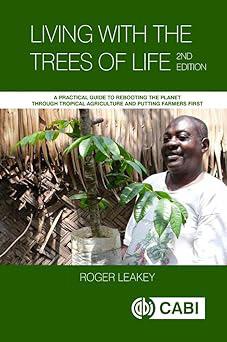
The theme of this book is that “agriculture needs to shift from environmental culprit to environmental, social, and economic savior” while intensifying production to serve an ever-growing human population. The means to do this is not to expand the Western practice of the green revolution into the tropics, but rather to apply the principles of agroforestry, championed by the author for more than 40 years, to small landowners throughout the tropics.
One of the chief obstacles to acceptance is the Western scientific/agricultural myth that indigenous crops are “famine food” suitable only when mass-produced field crops are not available. Furthermore, indigenous peoples do
not have the training and expertise required for intensive food production. Throughout the book the author confronts these myths with experimental evidence to the contrary. In fact, today Africa and Asia have more colleges and universities offering degree programs in Agroforestry than all of the developed countries combined, and Latin America has more than the U.S.
Leakey concedes that implementation of the green revolution “works” for monocultures of starchy crops in affluent countries that can afford the required chemical and water inputs. However, these techniques are not effective in tropical countries and furthermore cannot provide well-rounded nutrition. His background in botany and forestry led him to redefine Agroforestry beyond simple timber production and fruit and nut plantations. Rather, he defines it as “a dynamic, ecologically based natural resources management system that, through the integration of trees in farms and in the landscape, diversifies and sustains production for increased social, economic and environmental benefits for land uses at all levels.”
The first step is to discover “Cinderella trees,” indigenous trees recognized by local peoples for their fruits, seeds, oils, medicinal products, timber and/or ability to improve the soil as a “fertilizer tree.” More than 25 tree species, ignored by science, have been targeted for potential domestication. These were chosen by the indigenous people who also identified desirable traits for each. In a comparison of the nutritional values of the top two trees for West Africa—Dacryodes edulis fruit and Irvingia ganonensis seeds—with maize, rice, and cassava, levels of carbohydrate from the trees were one-half to one-third that obtained from the grains or tubers, but available fats/ oils, protein, and fiber were an order of
magnitude (or more) greater from the trees. Crop diversification, through Agroforestry, not only improves nutritional quality but also ecological diversity and soil fertility—two of several resulting ecosystem services. The key to the process is that the local farmers control the process, not only in choosing the initial trees, but selecting from offspring.
Contrary to the genetic approach to scientific breeding that dominates industrialized agriculture, Agroforestry depends on vegetative reproduction. Trees present a special problem for breeders because of their prolonged juvenile period—sometimes taking a decade or more before the first flowers are produced. Meticulous experiments on rooting stem cuttings have led to a five-step protocol that proved successful for all of the species of concern, is inexpensive, and can be performed by the local farmers. The latter, again, is key. Non-mist propagating chambers are essentially overgrown terraria. Rooting hormone (auxin) is applied to the proximal end of a single-leaf softwood cutting. Cutting location on the donor plant is a significant factor in determining reproductive maturity of the cutting. In one experiment, using a single donor tree, not only the years to eventual fruiting of the cutting (2–15 years), but also the eventual height reached by the cutting when it begins to flower can be predicted. Thus, there is potential variation within a single plant as well as between different stock plants. A final factor is the stock plant environment, especially light quality and shading effects. The farmer can now choose, improve, and propagate desirable stock for his farm or to share with neighbors.
In several case studies from different countries around the world, farmers have reached self-sufficient levels of production for their family within 2 to 3 years. At this point they
can focus on marketable fruit production or becoming a commercial nursery for other farmers. In either case the income begins to increase the farmer’s social and economic capital. In agriculture, domestication and commercialization tend to go hand in hand. This is particularly true for processing and marketing fruits that typically have short shelf lives. As with most topics in the book, the author notes both associated positive and negative aspects—in this case, a two-page table listing the social, marketing, and natural resource qualities that determine the positive and negative impacts of commercializing indigenous fruits and nuts.
The last few chapters identify some of the “ups and downs” affecting the adoption of Agroforestry around the world. The good news focuses on new tree crops brought into production and recognition of the multifunctional nature of agriculture. For instance, the recognition that deforestation and land degradation have major impacts on crop yield, hunger, malnutrition, social deprivation, and poverty. A major negative is that the grass-roots approach espoused by Leakey, which has not only been successful in identifying and introducing new crops, but in improving the lives of small farmers and the economy of local villages and countries, is being displaced by research stations and scientists in multinational corporations. Only slowly is indigenous knowledge becoming recognized by science (Levis et al., 2024). The “convenient truths” summarized by the author in the final chapter are that we have the knowledge and experience for improving agriculture “in ways that can help to mitigate the consequences of our profligate lifestyle. A lack of the political will to use this knowledge, however, remains a dominant ‘inconvenient truth’ hindering the salvation of our planet.”
This book is for everyone who realizes there is a conflict among food security, human well-being, and environmental sustainability and is looking for resolution. Leakey uses his professional career as a tropical botanist/ forester to scaffold this readable account of the potential for Agroforestry to provide that resolution. Each of the 15 chapters begins with an abstract and concludes with endnotes and a substantial list of further readings. It is accessible to any intelligent reader with an interest in environmental sustainability and would be an excellent focus for stimulating seminar discussions at any level.
Levis, C., J. S. Rezende, J. P. L. Barreto, S. S. Barreto, F. Baniwa, C. Sateré-Mawé, F. Zuker, et al. 2024. Indigenizing conservation science for a sustainable Amazon: Dialogues between Western and Indigenous systems are critical. Science 386: 1229–1232.
Marshall D. Sundberg. Kansas University Affiliate and Roe R. Cross Distinguished Professor of Biology – Emeritus, Emporia State University.
Malayan Orchid Review 2024 Annual, Volume 58
K. Gopalan (Editor)
2024. ISSN: 0219-7677
$14.80 (shipping free); 88 pp. Orchid Society of South East Asia, Robinson Road, P. O. Box 2363, Singapore 90363
The Malayan Orchid Review (MOR) was founded in 1931 by the Malayan Orchid Society (established 1928 in Singapore). Volume I (1931–1933) has three annual issues. The second volume spans 1934 to 1938. Volume III started in 1940 and ended in 1941 because of the Japanese occupation. Publication resumed in 1949 with volume IV. After irregular publication during the 1950s and 1960s, MOR became an excellent regular annual orchid publication starting in the late 1970s to early 1980s. In the late 1950s to early 1960s, it introduced color, probably before all or most other orchid publications.
The current issue contains articles present in most orchid publications: Awards, New Hybrids, and orchid show accounts illustrated with too small photographs and barely recognizable images of people.
Sad as they are, two obituaries on pages 39–41 put on record individuals who served the Southeast Asia orchid community well.
Four articles, containing helpful information regarding orchid cultivation in the area served by MOR, will benefit new and experienced growers. These articles by different authors on several orchids provide varied and interesting perspectives.
Two articles by different authors deal with breeding. One provides more general information about orchid breeding, for which Singapore is famous, having produced nearly 3500 hybrids (1.74% of the almost
194,500 world total; a very large proportion considering the small size and population of Singapore), starting with Papilionanthe Miss Joaquim (natural hybrid, 1893) and Spathoglottis Primrose (first human made hybrid, 1932). The second article concentrates on Dendrobium breeding in Indonesia. Both are well written, interesting, and informative.
There are three taxonomic articles, with two by the same author. One describes a new Malaysian Tainia species. Philippines Vanda species are covered in the second. Dendrobium macrostachyum is the subject of the third. All three articles should interest growers and breeders.
A personal travel account to Penang would not be missed if excluded. It invoked memories of my visit to Penang long ago. Photographs 2 and 3 and some pictures on p. 55 are not of much use.
The checklist of orchids in Penang Hill Biosphere Reserve (pp. 56-65) is excellent orchid biogeography within the constraints of a relatively short article. I hope that a longer, more detailed paper will find its way into a peer-reviewed journal.
That the Japanese occupation of Singapore during World War II was as harsh and cruel as the military could make it is well known (Corner, E. J. H., 1946, 1981; Holttum, 1953, 1977; Arditti, 1990; Corner, J. K., 2013). Less well known are the “principled Japanese men of science” described by E. J. H. Corner—for example, botanist, orchid scientist, professor, and general Kwan Koriba (Holttum, 1953, 1977; Arditti, 1990); Marquis Yoshichika Tokugawa; and Hidezo Tanakadate. Their stories must be told. The article (pp. 66–70) about the legendary R. E. Holtum (Holttum, 1953, 1977; Stearn, 1991) takes a stab at it and
does it very well, but a more detailed treatise is needed to fully credit these honorable and humane wartime Japanese scientists whose actions bring to mind Dickens in Tale of Two Cities: “It was the best of times, it was the worst of times, it was the age of wisdom, it was the age of foolishness, it was the epoch of belief, it was the epoch of incredulity.…” They behaved exemplarily and wisely during an age of foolishness and an epoch of cruelty and incredulity.
I have two criticisms of this article. First, it uses a weird system for citations in the text and references listing. It is confusing, is hard to follow, and does not provide enough information. Second, by citing what tries to pass itself as a legitimate book as reference 22, it lends credulity to a yarn made of manufactured history, whole cloth, contrived factoids, and incorrect information (all debunked by all major orchid scientists) about an orchid, spun by authors who are neither orchid scientists nor part of the “age of wisdom,” but participants in “the age of foolishness” (Arditti and Hew, 2007).
Being an annual publication MOR is like a book that contains a collection of articles. It is excellently designed, beautifully produced, and almost well edited. Almost, because it does not use a uniform citation and reference format. I like it and recommend it.
Full disclosure: During 1969–2011 I visited Singapore frequently to engage in orchid research, and write a book and papers at the National University (with P. N. Avadhani, C. S. Hew and the late A. N. Rao) and the Botanic Gardens (with T. W. Yam). Additionally, the Orchid Society of Southeast Asia elected me as a Fellow many years ago.
Arditti, J. 1990. Kwan Koriba, botanist and soldier. Gardens’ Bulletin (Singapore Botanic Gardens) 42: 1-17.
Arditti, J., and C. S. Hew. 2007. The origin of Vanda Miss Joaquim. In: K. M. Cameron, T. Kull and J. Arditti (eds.), Orchid biology, reviews and perspectives, vol. IX (pp. 261–309). The New York Botanical Garden Press.
Corner, E. J. H. 1946. Japanese men of science in Malaya during the Japanese occupation. Nature 158: 63.
Corner, E. J. H. 1981. The Marquis–A tale of Syonanto. Heinemann Asia, Singapore.
Corner, J. K. 2013. My father in his suitcase. Landmark Books, Singapore.
Holttum. J. K. 1953. Orchids of Malaya. Government Printing Office, Singapore,
Holttum, R. E. 1977. A personal view of orchids. In: J. Arditti (ed.) Orchid biology. Reviews and perspectives, vol. I (pp. 15–24). Cornell University Press, Ithaca, New York.
Stearn, W. T. 1991. Richard Eric Holttum (1895-1990) botanist and religious thinker. The Linnean 7: 12-18
–Joseph Arditti, Professor Emeritus, Department and Developmental and Cell Biology University of California, Irvine.
Oak Origins: From Acorns to Species and the Tree of Life
Andrew L. Hipp
2024. ISBN-13: 9780226823577
Hardcover, US$35.00. 288 pp. The University of Chicago Press, Chicago, IL, USA
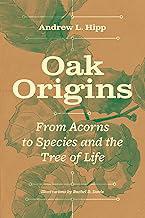
From cradle to grave and beyond, the mighty oak tree provides many ecological and economic benefits. Small oak seedlings often provide browse for wildlife. Expansive canopies of mature oaks provide shade for critters and humans alike on a hot summer
day. Wood from oak trees is strong, durable, liquid-tight, and has unique flavor profiles that all can be leveraged for barrel making to produce wine and whiskey. While we often think about the explicit values of oaks, we rarely stop to think about where our beloved trees came from. In a time when everyone is finding out ancestry for themselves and their pets, we should also consider the history of the flora that have, at least in part, driven the success and survival of humans and other animals for eons. Oak Origins: From Acorns to Species and the Tree of Life is a book by Dr. Andrew Hipp, the herbarium director and a senior scientist at The Morton Arboretum. The book is organized into nine chapters, including an introduction and epilogue. It includes a thoughtful foreword by Béatrice Chassé, an appendix of oak names, notes with citations for further reading about topics mentioned in each chapter, and a long list of all the literature cited within the book.
Hipp begins by defining “What is an oak?” via many different classifications, ranging from the basic identifying characteristics of the genus Quercus to more complex interpretations of that question that focus on the evolutionary history of the genus and the intrinsic value that oaks provide for other life forms. This introductory chapter also provides some context regarding nomenclature, his use of the term “Tree of Life,” geological time, and climate. After the introductory chapter, more context is given in the chapter titled “Flowers and Acorns.” This chapter paints a picture of oaks throughout space and time, and focuses on how different sections of oaks flower, are pollinated, and produce acorns. Hipp stresses how oaks rely on scatter-hoarding squirrels, jays, humans, and even now extinct species, like passenger pigeons, to disperse and colonize new areas.
Discussions of species range overlap and interspecific pollination segue into the second and third chapters, which focus on variation and hybridization in oaks, respectively. Oaks are highly variable in their traits due to phenotypic and ecotypic plasticity, hybridization, or some other factors that drive variation in plant morphology. The second chapter discusses some of these causes of variation, starting with sun and shade leaves and working up to heritable traits that can be tested in common garden experiments. Charles Darwin’s observations and theory of descent with modification through variation and natural selection are cited to provide some context for future discussions of evolutionary ecology within the book. Hybrids are more heavily discussed in the third chapter, which also focuses on differentiating species within Quercus, the most diverse genus in North America. Like many other places in the book, Hipp shares stories of trees in his life to provide perspective for the scientific material he is conveying. In this chapter, he mentions the characteristics of the swamp white oak in his yard compared to the bur oak and white oak down the road from his house. All three are species that are considered “good species” due to their distinct characteristics, though they do have the ability to hybridize. This third chapter unpacks different definitions of species, making it more relatable to nonbotanists by citing examples of speciation in animals, namely humans. Ultimately, Hipp concludes that the oak Tree of Life is “riddled with interconnections,” which he elaborates on in subsequent chapters.
The origins of the family Fagaceae and genus Quercus are explored in the fourth and fifth chapters. Hipp paints a picture of the Cretaceous and the advent of Fagaceae and other angiosperms that were supporting new
life that gymnosperms could not support. Though the content may be a bit dense for non-botanists, Hipp does a good job of explaining terms as he weaves through the phylogenetic tree of clades and history of scientific research based on the fossil record and oak phylogenetics. The genus Quercus did not arise overnight, but rather over a long period of time in response to natural selection and changes in climate. Chapter six delves into the oak genome, relating it to the creation of “Pharaoh’s Dance,” a musical track that was composed from a bunch of spliced recording fragments. Hipp elaborates on the linkage maps and oak genomics research that have been created, primarily since the mid- to late1900s. In the chapter on oak communities, Hipp reminisces about his travels to study oaks worldwide and recalls research from other oak enthusiasts to describe the cooccurrence of oaks within ecosystems. He describes how “oaks are champions of convergence” and how two very different and distantly related oak species can have similar traits that have evolved independently over time, which cause them to prefer similar habitats. Though these distinct species share some traits, they typically do not share the same pests and pathogens, which reduces spread of health problems within an ecosystem. The same concept largely applies to beneficial insects and fungi, which contributes to the overall diversity within an ecosystem.
The last chapter, Epilogue, discusses oak adaptation and extinction. Though there are many oak species that have been negatively impacted in the Anthropocene, a bright light is the numerous conservation-oriented organizations that are working to conserve and preserve oak genetics around the world, with Hipp’s research at The Morton Arboretum contributing to this initiative. I
would be remiss to not include a note about the marvelous illustrations by Rachel Davis in the book, which bring the pages to life. Overall, this book is a fairly short, yet super informative, read for anyone interested in learning more about our beloved oak trees.
–A.N. Schulz, Department of Forestry, Mississippi State University, Starkville, Mississippi, USA
Philip Seaton and Lawrence W. Zettler
2025. ISBN-13: 978-0226839417 (cloth); ISBN-13: 978-0226839424 (e-book) $35US; 320 pp.
The University of Chicago Press
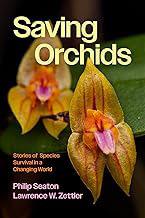
Orchids became imperiled when European collectors were sent to faraway places to collect plants for wealthy growers who paid high prices for them. No one seemed to care about the pillaging and environmental destruction caused by the collectors. Population growth, poaching, and orchid habitat destruction threaten extinction of some orchids at present (Hansen, 2000; https://www.cnyos.org/E%20 Hansen-letter.pdf ). This book deals with how to save orchids fromextinction.
Dendrophylax lindenii, the ghost orchid— the poster child in the United States for this impeding tragedy—is used to open the book and set its tone. Its story is told well and interestingly by the authors and guest writers. A photograph on p. 20 of a sphinx moth pollinating its flowers brings to mind Darwin and Angraecum.
Most orchid books start by describing orchids. These chapters may be necessary but can get boring and tedious. Both are avoided in this book because, instead of the usual narrative, the authors present the subject in several separate articles within Chapter 2. This makes for easier, interesting, and even fun reading.
A chapter inexplicably, and in my view inappropriately, named “The Way We Were” tells the story of collectors (and major horticultural establishments of the time who sent them to collect), the collecting, the damage caused by the “extraction of hundreds of thousands of plants from the wild,” their importation (mostly) into England, and their fate there. The chapter is neither too long nor too detailed to overwhelm and bore the reader and not too short to be insufficient. It is just right in content, interestingly illustrated, well written, informative, and a good read.
Several collectors (real or maybe not) wrote about their adventures (some actual and others perhaps not). It would have been good to refer more extensively to some of their stories. As it is, only one book by a collector is listed (Millican, 1891). I have that book and three others (Burdett, 1930; MacDonald, 1939; Löndorff, 1956) and highly recommend reading them even if only as adventure yarns. There are additional stories by collectors in the orchid literature.
Lessons in biogeography (Chapters 4–6) and taxonomy/nomenclature (Chapter 7) are interestingly presented and necessary in a book like this because they tell where orchids are found, which orchids are in danger of poaching or extinction, and, sadly, what name to use in a lament for an extinct species.
Conserving and saving orchids are daunting and not always undertaken when they should
be. I know, having observed several instances. One was of orchid plants left to die on trees felled to make land available for sugar cane cultivation on one of the Fiji Islands. Another was many years ago in Rangoon, Myanmar, where I saw a center where orchids removed from cut forest trees were taken, kept alive, made available for sale, and perhaps saved. More recently, I was present when orchid plants were placed on trees in Singapore as part of a restoration/repopulation program. Heavy equipment was involved, as was danger because snakes and biting insects and spiders lived in the trees. Fortunately, no one was harmed.
Information regarding successful restoration programs is important because it indicates that it can be done. Details are necessary since they show how to do it. That is why I think that Chapters 11 and 15 are important. They tell about several programs.
The Singapore program conceived and carried out by my former post-doctoral fellow, Dr. Tim Wing Yam and his associates, is spectacularly successful. Of 155 presumed extinct species, 62 were reintroduced and more than 40,000 plants were placed in more than 40 different locations (nature areas, roadside trees, and parks).
Most of the plants survived. Many of them flowered, were by natural vectors, and produced fruits and seeds. The seed became scattered, some germinated (Er et al., 2024; Yam, 2008, 2018, 2021; Yam and Arditti, 2018; Yam et al., 2007, 2010a, 2010b, 2011, 2016, 2020, 2021; Yam and Weatherhead. 1988), and seedlings are growing well. This means that the natural life cycles of these species were restored and their population became self sustaining. The plants became part of the local ecology because ambush predators hid in
them and preyed on their food sources (Yam et al., 2022).
There are two more than casual problems with this book:
• One is the use of small and smaller fonts throughout the book. This is especially bothersome in captions and the index. Decisions about fonts are made by publishers, not the authors.
• The second problem is insufficient references. The total number for the entire book (p. 204, “Further reading”) is 24, 7 by the authors, and one which may well be either romantic fascination by its author with a ruffian or fiction, but certainly not science. A book like this one should have been thoroughly referenced, preferably with all available references to allow for: (a) further study by readers, and (b) easy access to methods. The book is still good without enough references, but is less useful and seems not as scientific. To make up for the lack of enough references, I added more citations than usual to this review.
• A third problem is personal because: (a) I spent extended periods of time in Singapore, (b) I observed how the program is carried out, (c) I visited a large number of the locations where orchids were restored (including Grammatophyllum plants on trees on the small offshore island Pulau Ubin), (d) I saw many of the species in full bloom in their new but ancient homes, and (e) Dr. Yam is my former post-doctoral fellow. The problem is real because the Singapore restoration/repopulation program is very successful. It should have been presented with references
in more detail with a thorough discussion of the methods it used and the problems it faced and overcame for those who may wish to use this proven procedure in other locales. To correct for part of the problem, I added details and references to this review.
Because of their beauty and complexity, orchids enrich their natural habitats. They play important roles in the ecology of the areas where they exist. One example are the predators that hide in orchids (see above). Orchids also serve as food or beverage in some cultures, such as salep. Several orchids are national flowers in a number of countries, as Guarianthe skinneri is in Costa Rica. Many orchids are used as medicinal herbs. There are additional uses (Chapter 9). Altogether there are many reasons to conserve and save orchids (Chapter 8). This book is important because it:
• discusses why many orchids are in danger (Chapter 10)
• elaborates on the reasons for conserving and saving them
• tells how to save and conserve
• provides examples of how it is being done (Chapter 11)
• points to the way forward (Chapters 12–15, 17–19)
• does all of it well.
Despite the few problems I mentioned, this is a good book.
Burdett, F. D. 1930. The odyssey of an orchid hunter. Herbert Jenkins Ltd., London.
Hansen, E. 2000. Orchid fever: A horticultural tale of love, lust and lunacy. Methuen Publishing, London.
Löndorff, E. 1956. The forest of fear. Souvenir Press, London.
MacDonald, N. 1939. The orchid hunters. A jungle adventure. Farrar & Rinehart, New York.
Millican, A. 1891. Travels and adventures of an orchid hunter. Cassell & Company, Ltd., London.
Yam T. W. 2008. Conservation and re-introduction of the tiger orchid and other native orchids of Singapore. In: P. S. Soorae (ed.), Global re-introduction perspectives. re-introduction case-studies from around the globe (pp. 261–265). IUCN/SSC Re-introduction Specialist Group, Abu Dhabi, UAE.
Yam, T. W. 2018. Conservation, propagation and reintroduction of two-colored Cymbidium orchid in Singapore. In: P. S. Soorae (ed.), Global reintroduction perspectives: 2018. Case studies from around the globe (pp. 238–242). Gland, Switzerland: IUCN/SSC Reintroduction Specialist Group and Abu Dhabi, UAE: Environment Agency-Abu Dhabi.
Yam, T. W. 2021. Arundina graminifolia and Spathoglottis plicata, two common orchids in Tengah. Gardenwise 56: 7–10.
Yam T. W., P. Ang and F. Tay. 2016. Rediscovery and reintroduction of Robiquetia spathulata in Singapore. Gardenwise 46: 22–24.
Yam, T. W., P. Ang and F. Tay. 2020. Successful Reintroduction of native orchids to Zhenghua Nature Park. Malayan Orchid Review 54: 78-83.
Yam, T. W., P. Ang, and F. Tay. 2021. Conservation and re-introduction of red horntail orchid, a nationally extinct orchid species in Singapore. In: P. S. Soorae (ed.), Global reintroduction perspectives: 2020. Case studies from around the globe (pp. 350–353). IUCN/SSC Reintroduction Specialist Group.
Yam, T. W., and J. Arditti. 2018. Orchid Micropropagation: An Overview of Approaches and Methodologies. Pp. 151-178. In: Y. I. Lee, and E. C. Yeung (eds.), Orchid propagation: from laboratories to greenhouses – methods and protocols. Springer Protocols Handbooks.
Yam, T. W., J. Arditti and N. Anghelescu, 2022. Predators in orchids. Orchids 91: 820-933.
Yam, T. W., T. Aung, P. K. F. Leong and S. Chan. 2007. Galeola nudifolia - an extinct orchid. Gardenwise 29: 8-9
Yam, T. W., P. K. F. Leong, P.T. Chew, D. Liew and W. K. H. Ng. 2010a. Bulbophyllum pulchellum: Rediscovering and conserving a ‘lost’ orchid of Singapore. Malayan Orchid Review 44:109-112
Yam, T. W., P. K. L Leong, D. Liew, P.T. Chew and W. K. H. Ng. 2010b. The re-discovery & conservation of Bulbophyllum singaporeanum. Gardenwise, 35: 14–17.
Yam, T. W., P. K. F. Leong, D. Liew, P.T. Chew, S. Teo and W. K. H. Ng. 2011. Presumed nationally extinct orchid unveiled by a storm: Bromheadia alticola. Gardenwise. 37: 14-16.
Yam T. W. and M.A. Weatherhead. 1988. Germination and seedling development of some Hong Kong orchids. I. Lindleyana 3: 156-160.
–Joseph Arditti,
Professor of Biology Emeritus, Department of Developmental and Cell Biology, University of California, Irvine.
Caroline Ball 2023. ISBN-13: 9781851245970
US$25 (Hardcover); 144 pp. Bodleian Library, University of Oxford

Cacti and succulents have long fascinated both professional and amateur botanists. They combine survival in extreme environments, ecological importance, and exhibition of tremendous diversity. One trip to the Sonoran Desert in Arizona to see the Saguaro cacti was enough to convince me of their intriguing beauty.
This book is a handsomely illustrated work that combines botanical history with cultural exploration, focusing particularly on the historical illustrations from the 18th-century German botanist Johann Wilhelm Weinmann. The book traces how cacti and succulents have fascinated humans throughout history.
The author discusses their practical and medicinal uses in as well as some current scientific research. An example of the latter is research on CAM (Crassulacean Acid Metabolism), an adaptation that allows cacti to survive in extremely dry environments by time-shifting when they collect carbon dioxide during photosynthesis.
The last chapter offers recommendations on where to see cacti and succulents. In North American, the author offers Saguaro National Park and the Sonoran Desert Museum in Arizona and the Huntington Desert Garden in California. Of course, the great botanical gardens, such as Kew Royal Gardens in England, have fabulous collections of these plants. One minor critique: the book lacks an index, which would have been helpful.
This book will appeal to multiple audiences: garden enthusiasts, botanical historians, and other amateur botanists. The author’s approach combines scientific understanding with aesthetic appreciation of these interesting plants.
–John Z. Kiss, Florida Institute of Technology, Melbourne, FL
Jennifer McElwain, Marlene Hill Donnelly, and Ian Glasspool 2021. ISBN 978-0226534435
US$30 (Cloth); 152 pp. University of Chicago Press
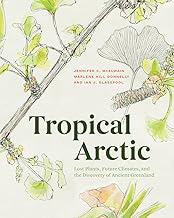
This book intertwines paleobotany and art to reconstruct and depict the Mesozoic forests of Greenland. These forests were affected by dramatic climate change that drove the global mass extinction event at the close of
the Triassic. Reconstructing their collapse and recovery informs, and is informed by, our understanding of modern forests and the consequences of current climate change. Throughout the book, the authors incorporate discussion of scientific methodology and artistic techniques that encourage the reader to see scientific phenomena in a new way. This book will be a compelling read for anyone who has an interest in paleobiology, forest ecology, the Mesozoic, botanical art, or climate change.
This book begins with the story of the authors’ scientific expedition to Greenland in 2002. The descriptions and images of the arctic landscape and modern vegetation emphasize the remoteness of the area, as does the discussion of some of the challenges faced by the team, including injury and expense. The authors describe the geologic age, the type of fossil preservation, and the nature of the environments represented in their collection beds and discuss their approach to fossil sampling. They also describe their methods for reconstructing both individual plants and the ancient ecosystem. Overall, this chapter provided an excellent overview of paleobotanical fieldwork, and it feels like a behind-the-scenes look at facets of this work that are not always described in print.
In the next three chapters, the authors describe their reconstructions of the forests of Greenland, beginning in the Triassic and continuing into the Jurassic. Uniquely, this is addressed through a discussion of how plant species, traits, and ecological phenomena, which are understood through scientific methods, can be depicted through art. For example, in the chapter discussing Triassic forests, the authors discuss complex concepts such as “longevity,” “fertility,” and “complexity” as they apply to the forests of
ancient Greenland, including how they can be defined in a scientific sense and accurately conveyed through art. The text is accompanied by images of sketches, paintings, and models created as part of this project. Many of the illustrations are close-up images of pertinent sections of a larger work depicting a dense Triassic forest filled with woody trees and ferns. The full reconstruction is revealed as a stunning double-page spread at the end of the chapter. This strategy is repeated in the next two chapters, as well.
In Chapter Three, the authors describe the transition between the Triassic and Jurassic, which was marked by global mass extinction. This chapter focuses on the impact of global forces on the ecosystems represented by the sampled fossil beds, including a fern spike that is revealed by both leaf and spore data. Again, biological phenomena are discussed through the lens of how these might be depicted in art. For example, the authors discuss how exposure to sulfur dioxide affects modern plants and how this can be illustrated in their depictions of the plants recovered from their field site.
Finally, the authors describe the recovery of forests in the Jurassic, discussing how Jurassic forests differed in abiotic characteristics and species composition. This chapter also includes sections that address fundamental concepts such as the carbon cycle and geologic dating. Ultimately, the authors explicitly address how information gleaned from the study of the Triassic to Jurassic boundary informs our understanding of current climate change and the potential response of extant plants. They provide an excellent and timely argument for the importance of ecological and botanical research and how knowledge of the past informs our understanding of the future.
At the end of the book, the authors include an appendix they call “A Fossil Plant Gallery” with 14 brief descriptions of relevant fossil taxa, such as Czekanowskia, Equisetites, and Lepidopteris. These discussions of identifying traits, history of discovery, and the taxonomy of these fossils are accompanied by representative images. As I was reading the book, I often wished that the authors had included a photo of the fossil to accompany the text instead of, or in addition to, this appendix, but the comprehensiveness of the appendix is very useful and is a highlight of the book. If I was reading the book again, I might begin with this appendix. There is also a comprehensive list of references for further reading and an index.
This book packs a lot of information into a concise and visually attractive package. The chapters are divided into sub-sections with titles such as “fertility,” “color and light,” and “resilience” that pique the reader’s interest and make it easy to read in sections if time or attention span is limited. The chapters include enough background information about basic scientific concepts to be accessible to a general, educated audience. The discussion of botanical art and illustrations should draw in anyone with an interest in art or science communication. Further, the discussion of the forest reconstructions and descriptions of fossil plants are detailed and thought-provoking. This book would serve as an excellent addition to reading lists for university classes covering relevant topics, and I will likely assign it my Plant Evolution course. It is also a beautiful book full of intricate and complex illustrations that would add to any home or office library.
–Mackenzie Taylor, Creighton University
When the Earth was Green: Plants, Animals, and Evolution’s Greatest Romance
Riley Black 2025. ISBN: 978-1250288998
US$29 (Paperback); 304 pp.
St. Martin’s Press
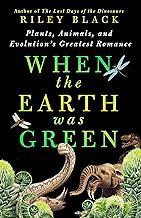
Plant–animal interactions are incredibly important, with the plant partner often being severely underappreciated by non-botanists. In “When the Earth was Green: Plants, Animals, and Evolution’s Greatest Romance”, Riley Black attempts to highlight these interactions for a broad audience from the perspective of the plant. Black is a paleontologist and author, likely most well-known for her book “The Last Days of the Dinosaurs” and popular press articles. In this book, they highlight unique plant–animal interactions throughout the geological time record by painting pictures of 15 unique instances, from 1.2 billion years ago until the end of the last ice age.
Black sets the stage of each chapter with a title, time, and location, while her evocative prose describes the scene in detail. The focus of each chapter is on either a major evolutionary innovation (e.g., sexual reproduction) or iconic extinct species from that time period, including some scientific names and descriptions, as well as slightly anthropomorphized anecdotes from the perspective of individuals of these species. Each chapter also includes illustrations of the major characters by Kory Bing. I can see why some would find this writing style and overall approach appealing, but I personally found it a bit distracting, and it was sometimes difficult to discern fact from fiction.
Although plants are highlighted more than many popular science books, I still found this work to be a bit animal-centric. Some of the chapter themes are a bit nebulous or lack aspects of basic botany that might benefit readers. For example, Chapter 6 (“In Bloom”) briefly discusses flowers, then focuses more on seed dispersal, and overall it misses the opportunity to explain what flowers and fruits actually are in the botanical sense. Chapter 8 (“Rainforests and Revival”) mentions pollination but again does not provide explanations for those who are not familiar with pollination, while Chapter 11 (“Partners in Pollination”) discusses bats as pollinators, but more in terms of floral attraction and rewards. There were also some small inaccuracies that might bother a botanical expert, such as referring to “Ginkgo fruits.” Each chapter has a corresponding appendix
at the end of the book that dives more into the scientific background and some of the author’s reasoning for choosing each topic, as well as a references section at the very end that includes citations for each chapter.
I found the Introduction and Conclusion sections more compelling, as the author discusses some of their own experiences as a paleontologist and queer individual and extending perspectives on plant resiliency and diversity to the human condition. I think that this book could be a good fit for those desiring science fit in with vivid depictions of imagery, but it may not be meant for those with more substantial backgrounds in botany or looking to learn about plant evolution in detail.
–Nora Mitchell, Department of Biology, University of Wisconsin – Eau Claire, Eau Claire, Wisconsin, USA
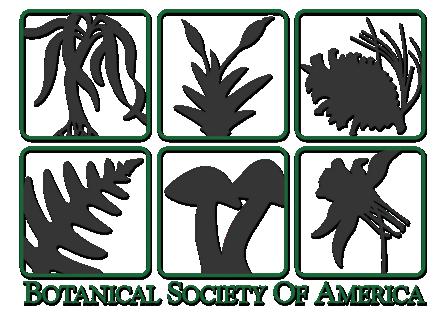
ISSN 0032-0919
Published 3 times a year by Botanical Society of America, Inc. 4475 Castleman Avenue St. Louis, MO 63166-0299
Periodicals postage is paid at St. Louis, MO & additional mailing offices.
POSTMASTER: Send address changes to: Botanical Society of America Business Office P.O. Box 299 St. Louis, MO 63166-0299 bsa-manager@botany.org
Address Editorial Matters (only) to:
Carolina Siniscalchi, Editor Mississippi State University Libraries 395 Hardy Rd P.O. Box 5408 Mississippi State, MS 39762 USA Phone (662) 325-9346 psb@botany.org
The Botanical Society of America is a membership society whose mission is to: promote botany, the field of basic science dealing with the study & inquiry into the form, function, development, diversity, reproduction, evolution, & uses of plants & their interactions within the biosphere.
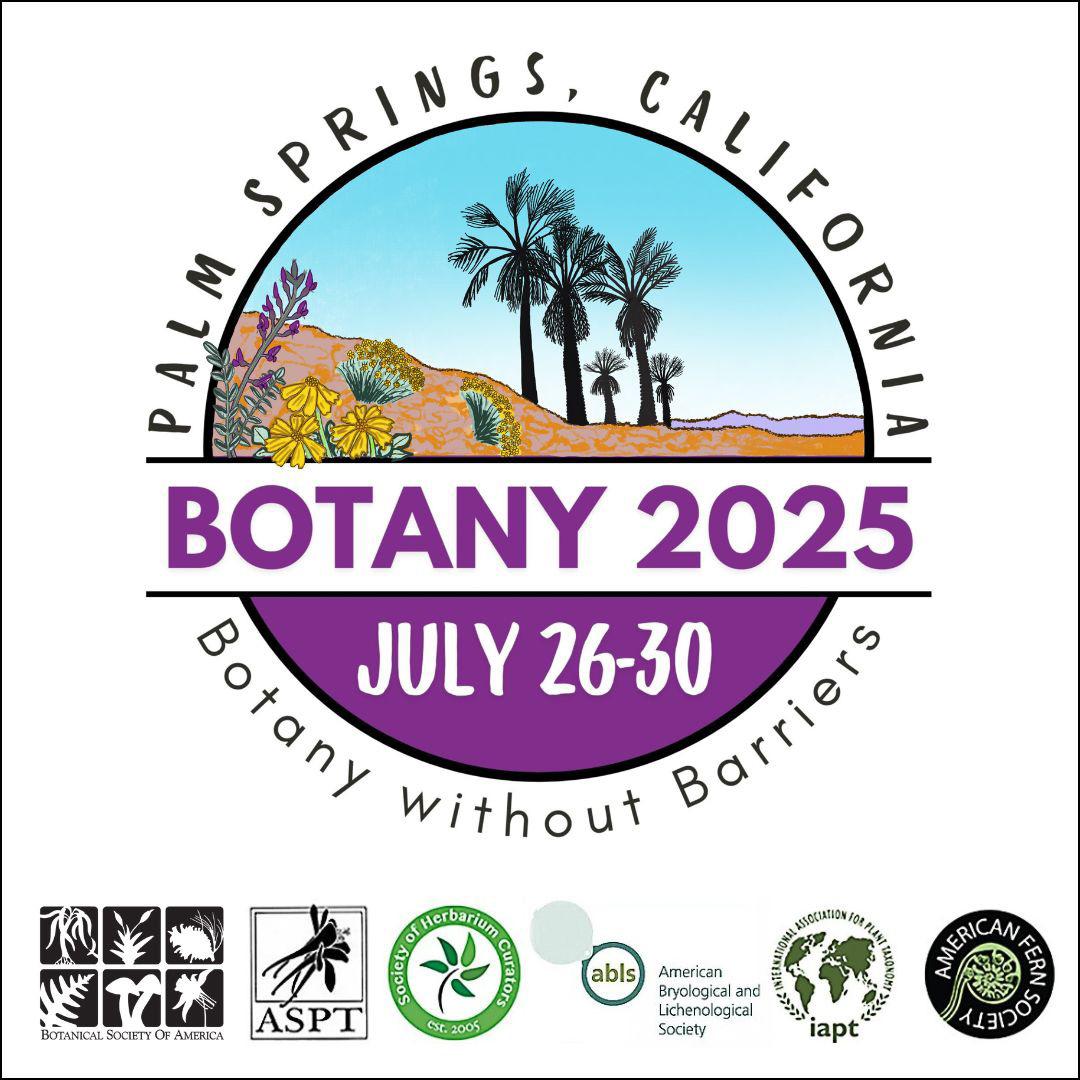
Visit the Botanical Society of America booth and:
• Learn more about the new BSA podcast
• Get your publications questions answered by BSA publications staff
• Receive a special membership gift for renewing early, purchasing 2 or more gift memberships, or making a donation of $50 or more
• Help us celebrate our 50th BSA Spotlight with a unique free takeaway
• and head over to the BSA photo booth to take a fun picture with great Palm Springsinspired backgrounds!
When done, visit the PlantingScience booth right next door and find out how you can be a mentor and help celebrate 20 years of PlantingScience showing middle and high school kids how interesting plants can be.

You share your research stories in scientific journals, and the LI-6800 is designed to safeguard the collection and quality of publishable data. Automated adjustments of experimental parameters combined with stable control of non-experimental parameters empower you to test hypotheses with high confidence.
The LI-6800 features novel advancements not found in any other photosynthesis system:
• Aquatic measurements—CO₂ gas exchange from algae and other aquatic samples.
• Multiphase Flash™ Fluorometer—flash intensity of up to 16,000 µmol m -2 s -1 .
• Dynamic Assimilation™ Technique—faster CO₂ response curves.
The LI-6800 is the global standard for photosynthetic gas exchange and chlorophyll a fluorescence measurements.